Abstract
This study presents the initial scientific characterization of the recently discovered Rhizoliths Petrified Forest of Chania, located at Stavros in the Akrotiri peninsula of Crete, Greece. Unlike most known petrified forests that primarily preserve tree trunks, this site uniquely features an abundance of rhizoliths—fossilized root systems preserved through calcium carbonate mineralization. The rhizoliths exist within aeolianite formations along the coastal front, with diverse morphologies and sizes ranging from small trace-like forms to massive, branched structures exceeding one meter in length. The rhizoliths are exposed within historic Venetian quarries that operated from Minoan times through the medieval period at Stavros Bay, where quarrying operations have revealed these fossilized root systems preserved in coastal dune deposits. The site also contains in situ petrified trunks, calcrete formations, and biokarstic dissolution features that further enhance its scientific value. Microscopic examination of rhizolith samples has revealed valuable information about their internal structure, showing clear biogenic characteristics. The preservation of rhizolith structures and associated sedimentary features provides valuable insight into the Quaternary paleoenvironment, including former vegetation patterns, soil stabilization processes, and paleoclimatic conditions. The alternating layers of aeolianites and paleosols suggest cyclical environmental changes, with periods of active dune formation alternating with more stable conditions allowing soil development and vegetation establishment. This study documents the Stavros rhizoliths and their paleoenvironmental significance, contributing to the comparative understanding of similar features documented at other global sites.
1. Introduction
Bronze Age antiquities in the Chania region of Crete, Greece have been studied since the late 19th century, but significant archaeological discoveries began primarily in the mid-1960s. The Akrotiri peninsula, surveyed extensively through the Chania Archaeological Survey Project, has revealed over 245 prehistoric sites. Initial settlements date to the Neolithic era, including the earliest known site in western Crete [1].
The Lera Cave, nestled within the steep mountain massif of Bardia east of the se-cluded Trachili Bay, stands as a significant archaeological site containing artifacts from the 5th–4th centuries BC. This ancient sanctuary served as an important cult center dedi-cated to the worship of the Nymphs and Pan [2]. In the northwestern area of the Akrotiri peninsula, the coastal zone surrounding the settlement of Stavros, west of Trachili Bay, has come to be called Stavros Bay. Τhe wider Stavros bay area hosts one of Crete’s most significant quarry regions (Figure 1). Extractive operations at this site trace their origins to the Minoan period, continuing through the Middle Ages under Venetian oversight [3,4] and persisting into the modern era.
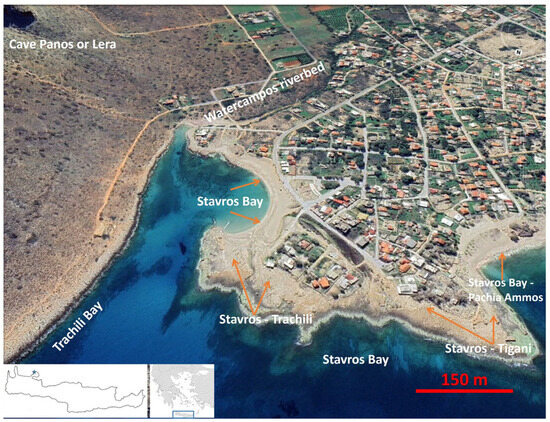
Figure 1.
The settlement of Stavros in the northwestern area of Akrotiri. On the right is the mountain range that hosts the Panos or Lera cave. To the west, between Trachili Bay and Stavros Bay, the Nerokampos River (Watercampos) flows into the sea. Two distinct sections of the Stavros quarry area are visible: the eastern Stavros–Trachili quarry and the western Stavros–Tigani quarry. Further west lies the sandy section of Stavros Bay known as Pachia Ammos. Arrows indicate the precise locations of interest in the Stavros area. The red line serves as a scale reference, measuring 150 meters in length. In the blue box is the area of the island of Crete, and with the star is the study area in Stavros on the Akrotiri peninsula. For better overview, the image has been rotated 180 degrees. Modified background from Google Earth.
This site is particularly noteworthy for the abundance and diversity of its rhizolith assemblages within coastal aeolianite formations, providing valuable insights into ancient coastal vegetation dynamics in the Eastern Mediterranean. While rhizolith preservation occurs in paleosols worldwide, the combination of extensive root system preservation with in situ petrified trunks and the coastal dune setting makes this assemblage scientifically significant for understanding Quaternary paleoenvironmental conditions in Crete. The discovery occurred within and adjacent to Venetian quarries, where coastal aeolianites have preserved these ancient plant remains. The latter has been interpreted as vestiges of a coastal “alsyllion”—a paleo-woodland that once thrived in this region [5]. Although the temporal relationship between the petrified forest formation and specific periods of human occupation requires further chronological investigation, the site’s location within historically significant quarrying areas adds cultural heritage value to its paleoenvironmental importance.
This paper presents a relatively wide range of findings from an ongoing investigation of a newly discovered Rhizoliths Petrified Forest of Chania, at Stavros, in the Akrotiri peninsula, Chania, Greece. Unlike most known petrified forests that primarily preserve tree trunks, this site uniquely features an abundance of rhizoliths—fossilized root systems preserved through calcium carbonate mineralization. The rhizoliths exist within aeolianite formations along the coastal front, with diverse morphologies and sizes. Various biokarstic features, including dissolution pipes, rock pools, as well as calcrete horizons, and fossilized trunks, stumps and tree branches further characterize this site.
2. Geological Outline of the Akrotiri Peninsula
The Akrotiri peninsula, located near Chania on the island of Crete, extends northeastwards and covers about 100 km2. Its geomorphology comprises three distinct regions: rugged mountainous terrain in the northeast, a karstified stepped plain called “kampos” in the southwest, and a predominantly steep, rocky coastline with scattered sandy beaches and small harbors (Figure 2). The study area is located within the northern area, which consists of karstified Mesozoic recrystallised carbonate rocks that form the coastal aeolianite formations containing the rhizoliths. This area exhibits characteristic karst landscapes including sinkholes and dolines. The southern area is dominated by Neogene marly limestones.
The study area is specifically located in the northwestern part of the Akrotiri peninsula, around Stavros village, within and around the Venetian quarry, extending along the coastal front over an area exceeding 700 m in the western part of Trachili Bay. The impermeable basement consists of marble layers with metachert nodules belonging to the Plattenkalk Group. Overlying these metamorphic rocks with angular unconformity are highly fractured anchimetamorphic carbonates of the Trypali Unit [6]. Based on newer work for the wider study area [7] and personal field work, the surrounding hills to the east of the area are composed of recrystallized carbonate rocks with intense fragmentation and texture resembling the semi-metamorphosed carbonate formations of the Trypali Unit, rather than the limestones of the Tripolis zone as indicated on the existing geological map of the Khania (Chania) sheet [8] (Figure 2).
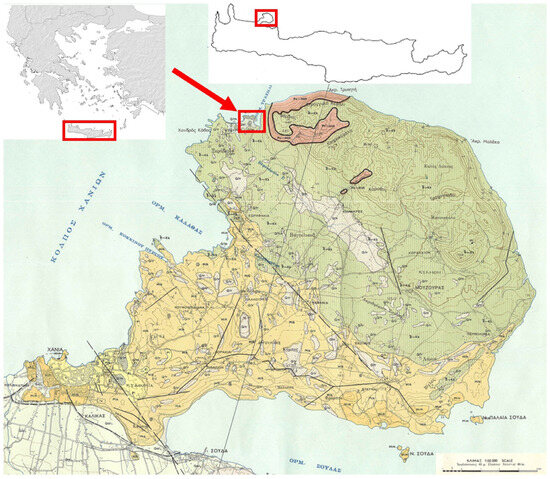
Figure 2.
Part of the basic geological map of Greece at a scale of 1:50,000, sheet Khania (Chania) [8]. Extract from the geological map legend: Quaternary; Qtr: Depositsof terra rossa in karstic hollows; Qtm: older sea terasse: 2–3 m in elevation of cohesive sandstones (Pleistocene). Tr-kk: Tripolis Zone Triassic(?)—Cretaceous—Limestones: compact, white grey to bluish, microcrystalline to aphanitic usually with rudist fragments, sometimes breccias at places dolomitized, strongly karstified. They may include lower members of Jurassic to Triassic age, not proven, though, paleontologically. In the red boxes are the regions of the island of Crete, the Akrotiri peninsula, and the study area in Stavros. The red arrow indicates the exact location of the study area. For more details, compare the geological map of the area, Supplementary Material S1.
The geological boundary between the older Mesozoic carbonate rocks and the younger Miocene-Pliocene deposits stretches along the middle of an extensive plane surface, having a general southeast-northwest direction and dipping to the northwest. Neogene sediments cover about 50% of the peninsula and are mostly made up of the Akrotiri Formation. For the most part it seems to overlie Mesozoic limestones and, therefore, has a conglomerate base [9]. The Trypali Unit at Akrotiri is mainly composed of gray, intensely karstified metamorphic limestones. These limestones also appear extensively across the main massif of the White Mountains. Locally, they may exhibit breccia-conglomeratic textures, vary in color from white-gray to bluish, and are partially dolomitized. Beyond these two major rock categories (Alpine and post-Alpine), which, as shown on the geological map, contribute nearly equally to the area’s structure, a notable group of clastic deposits occurs along the western coast of Akrotiri Peninsula from Stavros Bay to Chania Bay: Pleistocene beachrocks, red paleosols, and aeolianites [10].
The peninsula’s morphotectonic evolution was significantly influenced by regional southern Aegean tectonics. From Oligocene to Middle Miocene, Crete was part of a larger landmass. Beginning in Middle Miocene, tectonic subsidence led to marine sedimentation until Late Pliocene. From Late Pliocene through Middle Pleistocene, renewed faulting and emergence of fault blocks gave Crete its present configuration, including Souda Bay Formation [9]. The most notable recent event was the uplift along the coasts of Western Crete during the 365 CE earthquake [11]. Historical records indicate gradual tectonic submergence from 4200 years BP until the fourth century AD, followed by sudden uplift of 1.5–2 m [12].
The drainage networks of Akrotiri are characterized by intermittent flow and morphologically very young valleys. There is only one spring of very low discharge in the east between the Mesozoic limestones and Neogene marly limestones. The hydrological network formed discharges on the surface water into the sea with an ephemeral river Nerokampos (Watercampos), located to the east of the study area (Figure 1).
3. The Study Area and the Structures of Interest
3.1. The Stavros Quarry Region at Akrotiri
In this wider area of Stavros Bay, a quarry region is documented in the Corpus of Ancient Quarries of Greece, with two locations: 417. Location: Stavros–Tigani and 418. Location: Stavros–Trachili [13]. This six-hectare coastal quarry area is a significant example of aeolianite extraction on the island. These biogenic calcareous sandstones display crossbedding and contain marine fossils including foraminifera, lamellibranches, echinoid remains, and calcareous algae fragments [14]. The aeolianites overlie beachrock and extend to an elevation of 16 m. They locally cover the red soil and, in places, the limestones. Over time there have been significant sea level changes affecting the quarry. Ιn the southwest of Stavros Bay, the land has risen by approximately 1 m. Conversely, a large portion of the eastern quarry’s base is typically covered with shallow water. A tidal notch at 0.50–0.60 m height inside the quarry serves as evidence of this submersion, corresponding to organic remains of Vermetus arenaria reaching up to 0.6 m above water level [14].
The eastern Stavros–Trachili quarry shows systematic inland-to-sea extraction with a 1 m protective seawall and up to four removed layers. The western Stavros–Tigani quarry occupies a significantly larger area than its eastern counterpart and shows more extensive exploitation. The quarry features a distinctive dam-like seaward front with 2–5 extracted layers depending on location. Various extraction techniques are preserved, including oblique strikes and herringbone patterns. Quarrying channels (0.02 m wide) remain visible, with evidence of smoothing techniques in some areas. Extraction terraces reach up to five levels, with a total excavated thickness exceeding 16 m across both quarry sections (Figure 3a,b). On the seaward side, structural material has been removed from three terraces, creating a channel that allows seawater to enter the quarry’s interior.
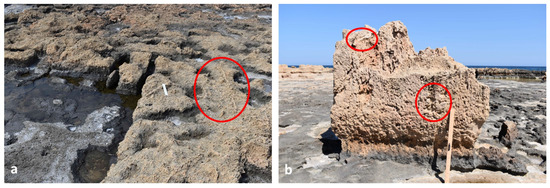
Figure 3.
(a) Partially submerged coastal aeolianite quarry at Stavros–Trachili, showing a flat extraction surface with clear quarrying grooves and shallow water resulting from subsidence; (b) Unquarried “witness pillar” displaying a visible tidal notch at its base, which indicates former sea levels. The scale is provided by a white 25 cm ruler and a large 100 cm ruler. Red circles highlight rhizolith remains in both images. Positions number/coordinates: (a)/6-35.593423709902, 24.094537597889, (b)/5-35.59346383017, 24.095228959992 (in WGS 84).
In both quarries, square “witness pillars” was left uncut and interpreted by Tziligkaki [3] to serve as reference points, like the obelisk found in the Clot del Mèdol quarry in Catalonia [15]. This formatting scheme is definitively Roman in origin. An intriguing question raised by these dual monuments of nature and extraction technology is whether the “witness blocks” were merely calculation positions or also monuments of respect for the fossilized roots revealed during quarrying. Close examination of these “witnesses” reveals remains of rhizoliths, remnants of fossilized trunks, and dissolution pipes in all of these structures.
The exploitation of quarries dates to the Minoan period and intensified during the Medieval period by the Venetians [3]. Venetian archives document the extraction of building materials from Stavros quarry, particularly during the later period when the walls of Chania were expanded and reinforced [16]. Moody [16] does not exclude the possibility that this quarry was used as early as the Bronze Age. The small height of some extraction steps could suggest medieval quarrying activity, as cuboid stones of that period typically had lower heights. On the floor of the Stavros quarry, the aeolianite debris created from the quarrying works has been cemented together with fragments of clay vessels. This diagenesis barely differs, if at all, from the diagenesis of the aeolianite. Modern exploitation of the quarry is evidenced by blast marks and electric wheel traces in the western quarry. Unfortunately, parts of this valuable archaeological site are at risk of encroachment by unauthorized housing developments.
3.2. Structures of Biogenic and Non-Biogenic Origin in the Study Area
The coastal quarries study area exhibits a complex assemblage of morphological structures with diverse origins. Aeolianites, which constitute the primary extraction material of the quarry, are calcareous sandstones formed through the lithification of wind-transported sediments, mainly of biogenic origin. These formations are rich in fossiliferous material, predominantly remains of marine organisms such as foraminifera, lamellibranches, and echinoid fragments.
Distinctly biogenic structures present in the study area include rhizoliths (fossilized root systems) and fossilized arboreal remains (trunks, stumps, and branches), which are described in detail and in relation to numerous other structures that have resulted from both abiogenic and biogenic processes. These include paleosols (ancient soil horizons formed through pedogenic processes), calcretes (indurated calcium carbonate accumulations resulting from evaporation and precipitation cycles), beachrock formations (lithified coastal sediments cemented primarily through inorganic precipitation of calcium carbonate), and dissolution pipes (vertical cylindrical features produced through localized biochemical dissolution). These features collectively contribute to the rich geological mosaic of the study area and will be examined in detail regarding their morphological characteristics. Special attention will be devoted to rhizoliths and the detailed description of their morphological characteristics, which have proven to be a determinative factor in the identification of these distinctive and extensive structures within a recognized archaeological site.
Rhizoliths: Morphology and Classification
Rhizoliths are diverse organosedimentary structures formed and resulting from complex biogeochemical interactions between plant roots, microorganisms, and surrounding sediments, exhibiting distinctive morphologies classified into several principal types based on their detailed characteristics and typically preserved through mineralization processes such as calcification, silicification, or gypsum precipitation [17,18,19].
Their formation involves root physiological activities, including transpiration and respiration, producing elevated concentrations of CO2 and organic acids, leading to the localized dissolution and re-precipitation of carbonate minerals [20,21,22]. Soil moisture and evapotranspiration play critical roles in rhizolith genesis, influencing the precipitation of secondary minerals by controlling mineral saturation states and ionic availability in the rhizosphere [22,23,24]. The resulting structures typically exhibit distinct concentric zoning composed primarily of micrite and sparite, indicative of repeated cycles of mineral precipitation and dissolution under fluctuating environmental conditions [25,26,27]. Preservation of rhizoliths is highly dependent on post-depositional conditions; intact, in situ rhizoliths are rare, typically found preserved within subsurface horizons, protected from extensive surface weathering and erosion, whereas those exposed at the surface often undergo fragmentation and chemical alteration, complicating paleoenvironmental interpretations [22,28]. Diagnostic criteria for distinguishing rhizoliths from animal burrows involve detailed analyses of morphology, branching patterns, internal structures, and mineralogical composition [28,29,30]. Rhizoliths typically exhibit tapering branching patterns with progressively decreasing diameters away from main vertical axes, indicative of their botanical origin, whereas animal burrows often maintain relatively constant diameters along their lengths and branches [27,31]. Additionally, rhizoliths frequently show internal concentric zonation due to successive mineralization events related to root metabolic activity, microbial influence, and fluctuations in soil moisture and geochemical conditions, a feature rarely seen in animal burrows [22,32]. Microscopic characteristics such as calcified root hairs, fungal hyphae, cellular-level preservation of original root tissues (e.g., cell walls, epidermal layers), and micritic structures further support their biogenic origin, distinguishing rhizoliths clearly from faunal burrows, which typically lack these fine-scale biological features [33,34].
The classification and morphological typology of rhizoliths has evolved significantly since Klappa’s [17] original framework, which established five primary categories: root moulds (tubular voids left after root decay), root casts (sediment-filled moulds), root tubules (cemented cylinders around moulds), rhizocretions (mineral accumulations around roots), and root petrifactions (mineral replacement preserving anatomical features). This foundational classification has been expanded through detailed micromorphological and petrographic investigations revealing internal structures such as concentric micritic and sparitic zoning, microbial filaments, and calcified root hairs frequently preserved in rhizocretions and tubules [28]. Additional specialized morphotypes include compound rhizoliths, which form through superposition of multiple growth and mineralization phases within the same root trace, often displaying cross-cutting relationships, overprinted fabrics, and complex diagenetic zonation [30]. Rhizohaloes represent another distinct type, characterized by subtle discoloration zones around roots caused by geochemical diffusion during active root respiration and decay, commonly occurring in association with more solid rhizolith forms [28]. Integrated classification frameworks now distinguish between primary in situ rhizoliths, which retain original growth position and relationship to soil horizons, and secondary rhizoliths, which have been reworked, compacted, or chemically altered beyond their initial pedogenic context [22,28]. The recognition of micro-rhizoliths, including mineralized root hairs and cellular structures, has further expanded the classification into microscale features, requiring thin section petrography and scanning electron microscopy for identification [33,35]. Based on mineral composition, rhizoliths may be categorized as calcitic (most common), siliceous, gypsiferous, or containing iron-manganese oxides, each reflecting distinct biogeochemical conditions during formation. Morphologically, rhizoliths may be classified according to their branching patterns, with vertical, horizontal, and dendritic forms recognized in various sedimentary contexts. Megarhizoliths or rhizocretion networks are particularly prominent in aeolianite deposits of coastal environments, often emerging in erosional relief due to differential cementation [5,36]. Finaly some rhizoliths, locally exhibit bulbous swellings, which were identified as rhizobial root nodules [37]. The classification system also considers the degree of anatomical preservation, with some exceptionally preserved specimens retaining cellular-level details of vascular tissues, epidermal cells, and root hairs, particularly in silicified examples from geothermal environments [17,38]. The combination of field observations—such as orientation, branching pattern, and stratigraphic position—with laboratory analyses, including thin section petrography, SEM imaging, cathodoluminescence, stable isotope geochemistry, and trace element profiling, allows for precise differentiation between rhizolith types and related biogenic structures [39].
4. Methodology and Restrictions
The study area in Stavros Βay, Akrotiri, belongs to a protected archaeological site. Therefore, field work can be conducted after obtaining permission, but in situ samples cannot be taken. The samples that can be collected for scientific research are fragments of rhizoliths that break off due to sea erosion, primarily during the winter and spring seasons. Beyond the fact that these samples require significant time to locate, they are naturally limited in both size and number. During the fieldwork, the photographs in the field were taken with a digital camera (Nikon D 3500, Nikon Corporation, Shinagawa, Tokyo, Japan). Τhe thin sections were made by the staff of the “Lithos” laboratory of the Hellenic Geological and Mineral Exploration Authority. Detailed observations of the microstructure of the rhizoliths were made with a Zeiss Stemi 2000-C stereoscope (Carl Zeiss AG, Oberkochen, Germany). The intralux® 5100 cold light source from a Harvard Apparatus was used as a light source (Volpi AG, Schlieren, Switzerland). This device has been specially developed for the illumination of Stereo Microscopes. Mineralogic studies were made using 12 specimens, representing 6 rhizoliths. Optical photomicrographs were made using a Zeiss petrographic microscope equipped (Zeiss Axioskop 40, Pol Research Polarized Light Microscope, Carl Zeiss AG, Oberkochen, Germany) with a 5-megapixel digital camera (Unibrain Fire-i™ 400 industrial camera, Unibrain S.A., Metamorfosis, Athens, Greece).
For the determination of the precise positions of the rhizoliths and other structures presented in this work, real-time kinematic positioning (RTK) was used utilizing a Satlab™ LS600 GNSS receiver (SatLab Geosolutions AB, Gothenburg, Sweden) and the HxGN SmartNet Greece RTK correction service, achieving precision within 1–3 cm in X-Y and 3–6 cm in Z. The initial measurements were taken in the EGSA 87 system and were subsequently converted to WGS 84 geographical coordinates, which were used to create a KML file. These data are listed in the Supplementary Materials: S2—Field positions of paleontological and sedimentological features with EGSA 87 coordinates; S3—Field positions of paleontological and sedimentological features with WGS 84 geographical coordinates; and S4—KML file. The position numbers of the measurements correspond to the chronological order in which the structures were documented within the study area. For each photograph presented in the text, the corresponding position number and WGS 84 geographical coordinates are provided in the figure captions.
The measurements of cross-bedded layer surfaces in the aeolianites were conducted using a classic Freiberg Geko SP compass. The processing and visualization of spatial geological layer data obtained from the measurements of cross-bedded surfaces in the aeolianites were performed using StereoNet 11 (Cornell University, Ithaca, New York, USA) [40], software designed for the analysis and visualization of spatial geological data. For surface processing in StereoNet 11, after inputting the dip values and dip azimuth, the program converted these data into point representations, great circles, and spatially grouped rose diagrams using equal-area (Schmidt net) stereographic projection. This representation allows for immediate visual assessment of the spatial distribution of the surfaces.
5. Morphological Characterization of Structures in the Investigation Area
The coastal site of Stavros Akrotiriou in western recently recognized after a brief presentation [5] as the “Rhizoliths Petrified Forest of Chania”. Situated within and around a historic Venetian quarry, the area contains an exceptional concentration of rhizoliths, preserved in lithified aeolianite dunes formed according to Zamani and Maroukian [10] during Quaternary glacial periods. These rhizoliths, ranging from small trace-like forms to massive, branched structures exceeding one meter in length, display outstanding preservation and diversity. In addition to rhizoliths, in situ petrified trunks, aeolianites, paleosols, beachrock, calcrete formations, and biokarstic dissolution features further enrich the site’s scientific value.
5.1. Aeolianites, Paleosols, Beachrock and Calcretes
As already mentioned, the Stavros region of Cape Akrotiri is underlain by Alpine basement rocks of the Trypali Unit, consisting of semi-metamorphosed, fractured, and highly fragmented carbonates, predominantly limestones and dolomites [6]. Directly overlaying these carbonates, thin layers of terra rossa soil developed (Figure 4). Although it is generally assumed that parts of the present land cover in Crete are the shallow remnants of formerly complete soil profiles that have been degraded by anthropogenic land use over the last millennia [41], recent studies help to understand the Terra Rossa soils in western Crete [42,43]. Terra rossa is typical Mediterranean soil characterized by an association of the Mediterranean climate, high internal drainage (due to the karstic nature of the underlying hard limestone), and neutral pH conditions. As residual soil type is rich in iron oxides, which imparts a characteristic reddish coloration [44]. Unlike typical Mediterranean reddish-brown soils formed through clay illuviation, soil-sediment profiles on Cretan slopes show remarkably weak Holocene pedogenesis. A key finding is the significant influence of Saharan dust inputs, identified through characteristic peaks in clay and silt grain size distributions. These inputs create unexpectedly homogeneous geochemical conditions across otherwise diverse landscapes [45].
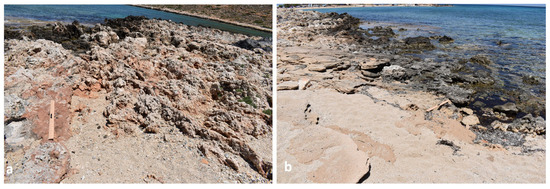
Figure 4.
(a) Slightly elevated karstified carbonate of Trypali Unit with terra rossa infill, likely representing older, uplifted coastal or shallow marine limestones now exposed to meteoric alteration; (b) shows the present-day coastal setting with actively forming or recently lithified beachrock, documenting ongoing interaction between sedimentary processes and marine diagenesis. The scale is provided by a large 100 cm ruler. Positions number/coordinates: (a)/34-35.59052468408, 24.096861007341, (b)/35-35.590548488056, 24.096714609505 (in WGS 84).
In Stavros Bay, the terra rossa is typically thin, rarely exceeding 0.5 m thick, reflecting relatively limited durations of subaerial exposure and pedogenic processes in these particular stratigraphic intervals. Pedogenic diagenesis subsequently transformed these thin terra rossa layers into consolidated paleosol horizons. These horizons act as clear indicators of distinct paleoenvironmental episodes [46], characterized by periods of soil stability and limited sediment input, allowing for significant soil development. Above these paleosols, discontinuous accumulations of beachrock occur as thin, bedded conglomeratic deposits. Formed in the intertidal zone, beachrocks [47] are cemented coastal sediments typically composed of sand-sized and gravel-sized clastic particles bound by carbonate cement precipitated from seawater. In the Stavros area, beachrocks vary substantially in their geometry, with each bed displaying distinct spatial variations in thickness, lateral extent, and inclination. These variations reflect not only the paleogeographic position of the shoreline during their formation but also the local hydrodynamic regime, including wave energy, tidal ranges, and nearshore sediment supply dynamics [48]. Specifically, the beachrocks west of the river mouth Watercampos (Figure 1) occur intercalated with terra rossa paleosols and the underlying fragmented carbonates of the Trypali Unit (Figure 4). Their characteristic geometry involves discrete, elongated benches several meters in length and width, with marked variations in elevation relative to the present sea level. Such vertical and lateral positional differences indicate multiple beachrocks generations associated with historical sea-level stands. Furthermore, beachrocks at the eastern part of Stavros beach developed atop sediments delivered by a significant alluvial fan system, itself intensely fractured and partially overlaying the in situ Trypali Unit carbonates. This complex interplay between terrestrial sediment influx, tectonic fracturing, and marine cementation highlights the intricate and dynamic geological history of the Stavros region (Figure 4a,b).
Paleosols represent a fundamental element of the Stavros Bay promontory stratigraphy, functioning as the primary substrate for plant growth. Within the Stavros area, paleosols are prominently characterized by their distinctive reddish coloration—commonly described as terra rossa. Such coloration typically arises from the pedogenic alteration of carbonate-rich parent materials under Mediterranean climatic conditions, leading to the concentration of iron oxides and hydroxides [49]. The terra rossa soils at Stavros appear repeatedly throughout the stratigraphic sequence, usually at the basal contacts of aeolianite layers, highlighting episodic cycles of pedogenesis interspersed with phases of aeolian sedimentation. These cycles [50] suggest alternating environmental conditions, where stable climatic phases allowed prolonged soil formation, later interrupted by active deposition periods associated with aeolian dynamics.
According to the classification system introduced by Birkeland [49], the paleosols at Stavros clearly fall under the category of buried paleosols—soils that were previously exposed at the earth’s surface but subsequently buried beneath younger sedimentary deposits. Their stratigraphic positioning and preservation within the aeolianites strongly indicate that after substantial pedogenesis and development of soil profiles, subsequent aeolian deposition episodes covered and effectively fossilized these terrestrial surfaces. The repetitive appearance of these buried paleosols suggests a rhythmicity in the paleoclimatic conditions, involving multiple episodes of climatic stability alternating with active aeolian sediment transport and accumulation. The horizons of these paleosols in the Stavros Bay promontory area are distinct, traceable, and well-defined throughout the site’s stratigraphy (Figure 5). The upper portions of these paleosol profiles frequently exhibit well-developed calcrete horizons, strongly indicative of intense pedogenic carbonate accumulation.
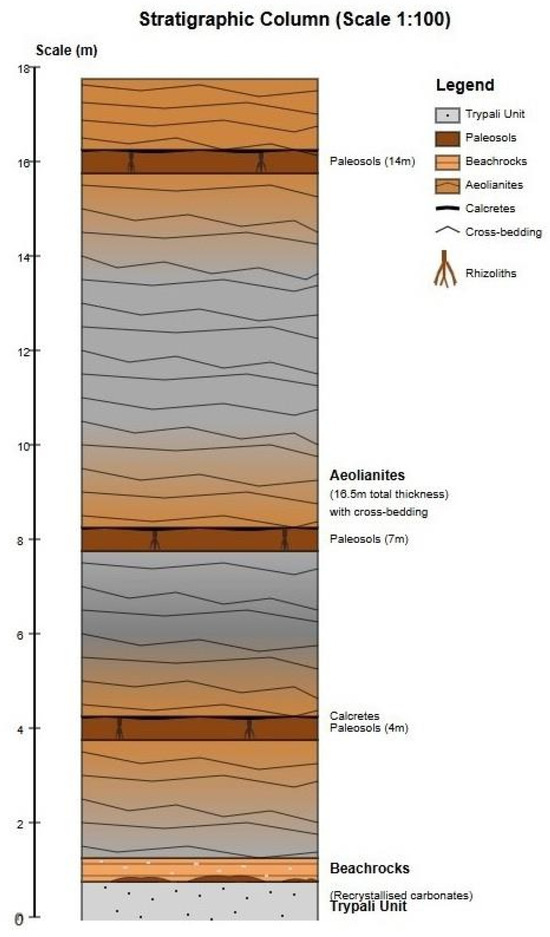
Figure 5.
Stratigraphic column of aeolianites in the quarry area of Stavros.
Their thickness, hardness, and the degree of cementation generally reflect prolonged exposure at or near the surface [49], enabling significant pedogenic modification and calcification. Some of the results of the above physical processes can also be seen in Figure 6a,b. In Figure 6a, the paleosol appears prominently within the aeolianite sequence and exhibits clear horizonation with well-differentiated layers. The soil profile is approximately 40–50 cm thick, measured against the scale provided by the stick (1 m). It consists of a reddish-brown horizon at the base that is suggestive of advanced pedogenesis, likely associated with oxidizing conditions and prolonged exposure. This basal horizon shows a strongly developed iron-rich layer, typical of Mediterranean terra rossa soils, characterized by iron-oxide coatings on grains and extensive carbonate dissolution features indicative of intense chemical weathering. Above this distinct basal horizon, the paleosol grades upwards into lighter brownish-beige sandy materials representing reduced pedogenic alteration, reflecting weaker chemical weathering processes or shorter soil-forming intervals. The upper boundaries of this paleosol are diffused and irregular, indicative of erosional truncation or depositional hiatus before the deposition of overlying aeolian sediment [32]. In Figure 6b, the paleosol is exposed as a well-defined layer underlying porous aeolianite deposits. The paleosol is about 25–45 cm thick, as indicated by the 25 cm ruler for scale, and presents a reddish-brown coloration characteristic of terra rossa paleosols commonly found in Mediterranean environments, developed under warm and humid conditions [51]. The upper boundary between the paleosol and the overlying carbonate-rich aeolian sediment is sharp and irregular, indicating a clear interruption in sedimentation and pedogenesis. Within this paleosol, there are abundant features of soil development including distinct aggregates, rhizoliths, and occasional lithoclasts. The presence of abundant rhizoliths signifies active vegetation cover during paleosol formation, suggesting a vegetated land surface with significant biological activity. The paleosol layer is densely cemented by carbonate, which indicates periodic wetting and drying cycles typical of semi-arid to sub-humid climatic conditions [23] during soil formation.
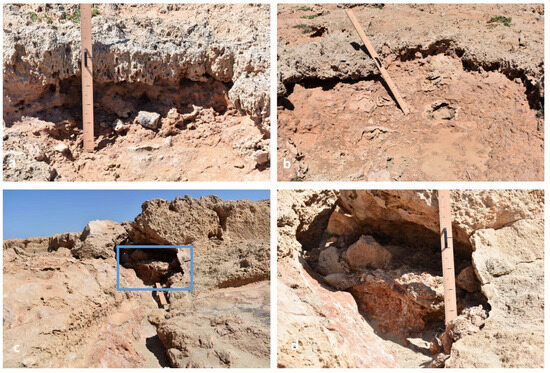
Figure 6.
Typical photographs of paleosols alternating with aeolianites in the Stavros area (compare Figure 5): (a) from the upper paleosol horizon, (b) from the intermediate, and (c,d) from the lower paleosol horizon. The area outlined by the blue box in Figure 6c is presented in greater detail in Figure 6d. The scale is provided by a large 100 cm ruler. Positions number/coordinates: (a)/16-35.593684784261, 24.091641185138, (b)/17-35.593656494314,24.091647908757, (c,d)/7-35.593517376707, 24.094476077451 (in WGS 84).
Aeolianites [52] constitute another essential lithological unit within the geological sequence of Stavros, forming significant sedimentary accumulations above beachrocks deposits or directly atop paleosol layers. These aeolianite deposits, originating from windblown carbonate-rich sands, reflect prolonged periods of arid to semi-arid conditions, along with significant aeolian activity and sediment transport. The aeolianites in Stavros Bay exhibit pronounced stratification characterized by cross-bedded structures, indicative of dominant wind directions and sediment transport pathways prevailing during deposition.
According to Zamani and Maroukian [10], the deposition of beachrock and overlying aeolianites along the western coast from Stavros to Chania likely occurred during the beginning of the last glacial period (Tyrrhenian III). These aeolianites represent ancient coastal dunes formed during periods of lower sea levels. The cold, dry conditions of this period, combined with the action of prevailing northwestern and western winds, facilitated the formation of these deposits. In contrast to this interpretation, Fytrolakis [53] proposes a sequential formation model. According to this alternative view, beachrocks formed gradually during sea level retreat, with aeolianites developing subsequently when the retreat reached its maximum extent. The aeolianite formations consist primarily of bioclastic material, including foraminiferal remains, bivalve shell fragments, echinoid spines (including the dwarf sea urchin Echinozyamus pusillus), and calcareous algae [14]. These materials indicate the marine origin of the carbonate sand that was subsequently transported by wind to form the dune systems. The aeolianites display characteristic cross-bedding structures, particularly evident in the quarry exposures, reflecting their aeolian depositional nature. The total thickness of aeolianites at Stavros, although difficult to determine precisely due to the limited exposure and laterally varying deposition patterns, does not exceed 16 m in total thickness based on the first measurements.
The aeolianite exposures at Stavros quarries region, Akrotiri peninsula, exhibit distinctive sedimentological and morphological characteristics indicative of wind-mediated carbonate deposition processes. The outcrops demonstrate pronounced stratification heterogeneity, with bedding orientations ranging from horizontal to inclined, accompanied by significant porosity gradients and differential cementation patterns. Figure 7a presents an aeolianite sequence characterized by well-defined stratification with predominantly carbonate composition manifested in sandy textures of beige to pale brown hues, reflecting pedogenic influence during formation. The aeolianite formation demonstrates advanced lithification and weathering phenomena with extensive dissolution-induced cavities and channels; this lithofacies presents darker grey to brown chromatographic signatures attributable to enhanced biological activity and microbial colonization.
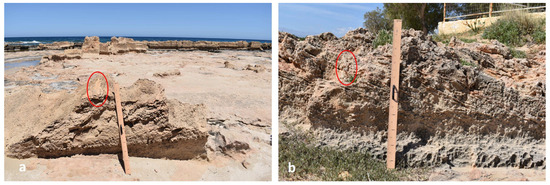
Figure 7.
(a) Cross-bedded aeolianite showing horizontal and inclined laminations from dune foreset structures. Pitted surface reflects selective weathering of partially cemented carbonate sands. Vertical root traces (within the red circles) indicate vegetation colonization during dune stabilization, supporting rhizolith formation and pedogenesis; (b) Densely cemented aeolianite with horizontal stratification and post-depositional bioturbation. Compact micritic matrix and undisturbed bedding indicate advanced diagenesis under stable conditions. Scale: 100 cm ruler. The scale is provided by a large 100 cm ruler. Positions number/coordinates: (a)/33-35.593464430541, 24.094856362649, (b)/135.592869341929, 24.095276815993 (in WGS 84).
Interbedded within the aeolianites are paleosol horizons, commonly only a few ten centimeters thick, which often preserve well-formed calcretes (pedogenic carbonate horizons). Calcrete, also known as “caliche”, describes a surface or subsurface accumulation primarily of calcium carbonate (CaCO3) in unconsolidated sediments, sedimentary rocks, and soils. These horizons represent former land surfaces upon which vegetation stabilized the dunes, allowing soil formation processes to develop. Calcretes occur in various morphologies: laminar crusts, nodular aggregates, and massive hardpans. Their genesis, as supported by Goudie [54] and Wright and Tucker [50] involves the vertical and/or upward migration of carbonate-rich solutions in semi-arid climates, leading to precipitation and cementation of CaCO3 in the soil profile. In some cases, rhizogenic calcretes [55] formed directly around root systems, contributing to the preservation of rhizoliths. Similar root-related calcareous accumulations are especially abundant in the red aeolianites and calcrete zones of the Stavros site, where dozens of vertical and horizontally oriented rhizoliths penetrate the paleosol–aeolianite interface. At Stavros Bay Akrotiri, extensive calcrete formations have been documented within aeolianite deposits, playing a crucial role in preserving rhizolith structures and recording the region’s paleoenvironmental history. The calcretes at Stavros Akrotiri appear in various morphological forms, including hardpan crusts (surface-hardened layers of several centimeters thick, forming extensive platforms), nodular calcretes (concretionary masses within the sediment), and laminar calcretes (thin, layered carbonate deposits exhibiting distinct laminations). These formations align with Wright and Tucker’s concept [50] of rhizogenic (root-formed) calcrete, where carbonate concentration is attributed primarily to root activity. At Stavros Akrotiri, calcrete crusts range in thickness from a few centimeters up to 25 cm and exhibit different colorations—those found directly above paleosols have a reddish color, while those within the gray aeolianites maintain their gray coloration. The largest occurrences of rhizoliths, preserved within these calcrete formations, are found on surfaces exceeding 50 square meters in the red calcrete crusts (Figure 8a,b). These areas contain the largest branched rhizoliths and mega-rhizoliths, representing significant paleoenvironmental archives. The site features extensive exposures of carbonate coastal platforms with prominent calcrete horizons that display characteristic textures and structures resulting from pedogenic and diagenetic processes. Relatively flat, indurated carbonate surfaces form extensive calcrete horizons exhibiting pronounced hardpan development with distinctive irregular microrelief and surface crusting. Such features typically develop under semi-arid to arid climates through cyclic episodes of carbonate precipitation, infiltration, and subsequent cementation within soil horizons, indicating prolonged subaerial exposure and landscape stability [56]. The presence of extensive calcrete horizons indicates periods of soil development under semi-arid conditions with seasonal moisture availability—conditions conducive to calcrete formation. The preservation of rhizoliths within these calcrete crusts provides additional evidence of past vegetation cover, allowing for reconstruction of plant communities that once inhabited this area. The varied morphologies of the calcrete formations further suggest multiple phases of development under fluctuating environmental conditions throughout the Quaternary period. The calcrete formations within aeolianites at Stavros Akrotiri offer valuable insights into the paleoenvironmental history of the region. These features record periods of landscape stability, vegetation establishment, and specific climatic conditions that prevailed during their formation. The calcrete crusts have played a critical role in preserving rhizoliths structures, particularly in areas where extensive calcrete development has protected these features from erosion. Further investigations of these calcrete horizons and associated structures may provide additional details about the timing and environmental conditions of their formation.
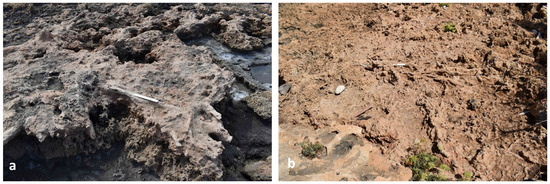
Figure 8.
(a) Shows complex structure with multiple rhizoliths preserved in hardened calcrete matrix (hardpan). Rhizoliths appear as elongated, light-colored tubular structures in brownish-tan sediment. One prominent rhizolith extends across surface, with 25 cm ruler for scale. Surrounding matrix shows rough, nodular calcrete texture from pedogenic processes in coastal environment. (b) shows individual rhizoliths in profile within calcrete horizon. Root structures retain original external morphology, including branching and curves typical of plant roots penetrating soil. Surrounding sediment shows distinct layering with reddish-brown calcrete horizons. Positions number/coordinates: (a)/12-35.593589231133, 24.094139660699, (b)/13-35.593406814915, 24.093935392086 (in WGS 84).
5.2. Rhizoliths
At Stavros Akrotiriou in Crete, an exceptional abundance of rhizoliths has been identified within aeolianite formations, representing one of the most significant localities for studying ancient root systems preserved through calcification processes. Rhizoliths represent the common term for all trace fossils of plant roots formed through plant–substrate interactions [17]. The preservation of root traces in the form of rhizoliths is commonly associated with palaeosols and induces physical and chemical changes in the host sediments. The formation of rhizoliths at Stavros followed a complex sequence involving initial root growth as coastal vegetation developed on dune systems in alternation with thin soils, followed by mineral accumulation as the interaction between plant roots, soil water, and carbonate created conditions favorable for calcium carbonate precipitation within and around the root structures. This process was likely enhanced by microbial activity in the rhizosphere, the zone immediately surrounding plant roots where complex plant–microbe interactions occur. After plant death, the decomposition process may have been interrupted by rapid burial under new dune deposits, allowing for exceptional preservation of the original root structures. Two primary mechanisms explain rhizolith formation: higher water uptake than Ca2+ by roots, associated with high CO2 from rhizomicrobial respiration, leading to CaCO3 supersaturation, and release of HCO3− by roots, increasing soil pH and causing CaCO3 precipitation [57]. This root encrustation process is considered relatively rapid, occurring over years to decades during or shortly after the plant’s life [20,26].
The rhizoliths at Stavros primarily represent root casts and root petrifactions, with many exhibiting excellent preservations of external morphological features. They occur less frequently root molds. Their occurrence within the aeolianites indicates that vegetation periodically stabilized the dunes, allowing for sufficient moisture infiltration and carbonate precipitation around the roots, reflecting climatic conditions characterized by pronounced seasonality and variable moisture availability. Mineral accumulation, such as calcium carbonate around root structures, reflects repeated wetting and drying cycles [23].
The rhizoliths at Stavros Bay can be classified by their host material (within paleosols, at the paleosol–aeolianite interface, within aeolianites, and in calcrete), morphology and size, and orientation. Based on morphology and size, four main types can be identified: (1) small-sized rhizoliths (few centimeters); (2) medium-sized rhizoliths (several centimeters) representing the most common biogenic structures within the aeolianites and displaying clear root morphology with primary, secondary, and tertiary branching patterns; (3) mega-rhizoliths (>1 m long) with impressive diameters often reaching several centimeters creating spectacular displays particularly in the gray aeolianites; (4) branched mega-rhizoliths (>1 m long) forming extensive networks covering several square meters with significant branching patterns.
The rhizoliths at Stavros Bay offer crucial information about past environmental conditions. In a broader context, the Stavros Bay rhizoliths can be compared with similar features documented at other sites worldwide. Calcareous rhizoliths are associated with drier soil conditions and arid to semiarid climates and are typical of well-drained environments. The extensive root systems suggest a relatively stable dune environment that supported substantial vegetation, likely during periods of more favorable climate conditions. The presence of calcification as the preservation mechanism indicates episodic drying of the soil for sufficiently long periods. The alternating layers of aeolianites and paleosols suggest cyclical environmental changes, with periods of active dune formation alternating with more stable conditions allowing soil development and vegetation establishment. The formation of calcite in and around root channels occurs during episodic drying of the soil [23] for a sufficiently long period.
The first category includes rhizoliths that resemble trace fossils but show not only characteristic branching patterns of the roots but also a characteristic internal structure that can be distinguished macroscopically and the phloem and the inner part of the root, with diameters ranging from 1 mm to 4 cm. These resemble trace fossils but show characteristic root branching patterns with decreasing diameter in secondary and tertiary branches. They appear in limited areas several tens of square meters, mainly in the western Tigani area within gray aeolianites, creating what resembles fossilized grasslands of similar plant species. These structures vary in diameter from 1 mm to 4 cm. Similar structures have been interpreted either as burrows [58] or as sea grass roots [59]. The basic components of the relatively well-preserved root structures include epidermal and cortical tissues. The good preservation of the morphology of many roots, at least of the structures and external morphology, shows that calcification occurred mainly before the death and destruction of the plants (Figure 9a,b). Rhizoliths of this type are found within aeolianitic strata that have been strongly eroded. Their occurrence within the aeolianites indicates that vegetation periodically stabilized the dunes, allowing for sufficient moisture infiltration and carbonate precipitation around the roots, reflecting climatic conditions characterized by pronounced seasonality and variable moisture availability.
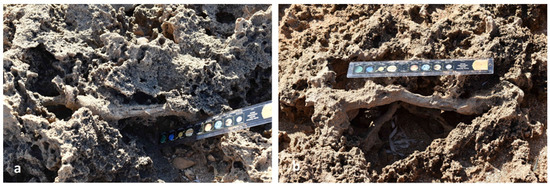
Figure 9.
(a,b) show well-developed tubular rhizoliths embedded in porous, weathered carbonate substrate. Both display intricate networks of interconnected cylindrical root casts, indicating dense past vegetation and intense pedogenic processes. These rhizoliths exhibit cylindrical morphology with excellent preservation of original root geometry. Scale: 35 cm ruler. Positions number/coordinates: (a)/19-35.593483703491, 24.092565811419, (b)/30-35.593201603688, 24.095580713879 (in WGS 84).
Τhe second category includes rhizoliths embedded in the eroded outer surfaces of calcretes (Figure 8a,b). These represent the most common biogenic structures within the aeolianites, particularly abundant in the reddish layers. They display extensive branching with size reduction from primary to tertiary order branches, forming cylindrical structures with either smooth or distinctly rough, nodular external surfaces. In most cases, these root fossils within the Stavros aeolianites appear so “alive” in their external form that they resemble living roots. These rhizoliths appear either as autonomous root segments or as clusters with different orders of branching. The external coloration varies and depends on the coloration of the surrounding aeolianite. The fossilization method varies from root to root. Following Wright’s [60] classification system of micromorphological features created by abiogenic and biogenic processes in pedogenic limestones, many of the samples show characteristic B-type (biogenic) microstructures. However, some root microstructures within the Stavros Akrotiri aeolianites are ring-type structures with a hole in the center or holes with rings, which are the result of preferential calcification of the cortical cells [55]. Ιn addition to those described above, rhizoliths of this category are found scattered within the aeolianites and at the interfaces between fossilized soils and aeolianites throughout the entire coastline. In places they form clusters of a few tens of rhizoliths. They number several hundred and are of various morphologies and are scattered over the whole area of the aeolianites. The diversity in spatial arrangement and density of the rhizolithe within the aeolianites reflects the distribution of vegetation in ancient sandstone landscapes and the degree of soil formation during the periods of sandstone stabilization. Dense clusters of vertically and subvertically oriented tubules mark zones of former root mats or shrub thickets, often confined to specific stratigraphic horizons associated with paleosol development or interdune deposits. These concentrations contrast with isolated rhizoliths scattered within cross-bedded dune units, which indicate ephemeral colonization and limited soil development [61] during short periods of landscape stability.
The third and fourth categories could be one, but there is an essential difference in the size of non-branching and branching rhizoliths. Alonso-Zarza [62] has described the megarhizoliths as different macromorphologies exposed as vertical columns in the field: (a) hollow cylinders with a cavity ranging from 1.5 cm to 15 cm, in some cases eccentrical, and only part of the most external wall preserved; (b) with more than one cavity containing micrite tubes; (c) with no cavity at all; or (d) with a cavity having a single central tube. Some specimens show lateral tubes that cut across the wall of the structure. In other cases, more than one cavity or micrite tube is included in the same structure. The most complex specimen observed shows a central cavity including a micrite tube with radiating ones that crossed the surrounding cavity and penetrated the external wall, a second smaller specimen connected laterally, and two rings of remaining indurated rock matrix. In contrast to the megarhizoliths observed in the Tufia columnar structures, the megarhizoliths observed in Stavros Bay are fossilized tree roots larger than one meter that preserved the morphological characteristics of the roots entirely during the fossilization process.
Τhe pronounced differences in the morphology of the fossil roots are shown in Figure 10a,b and Figure 11a,b: in Figure 10a, branching mega-rhizoliths (>1 m long) are visible within a rough, irregular aeolianite, illustrating typical branching and interconnectedness, indicative of root system development in paleosols. The complexity and branching patterns suggest former terrestrial conditions that supported extensive plant growth, subsequently replaced by carbonate mineralization [17]. These create extensive networks covering several square meters, with significant branching patterns. The most impressive aspect of these structures is not just their overall length and diameter but the extensive branching patterns that in some places create structures covering many square meters, while in other cases they appear in straight lines of many meters always with intense branch ramifications. Figure 10b reveals fossilized roots extending horizontally across the calcrete surface, partially buried within sandy material. Figure 11a presents a prominent aeolianite structure where rhizoliths clearly stand out as white, cylindrical features embedded within the aeolianite. The preservation is excellent, with visible continuity and clear differentiation from the surrounding matrix, confirming their biogenic origin and subsequent mineralization processes associated with subaerial exposure and pedogenic alteration. Lastly, Figure 11b shows a clear vertical exposure of unbranched fossilized roots penetrating through layers of aeolianite, indicative of plant colonization during soil formation phases and subsequent lithification processes. These rhizoliths appear robust, cylindrical, and slightly curved, representing the preserved traces of ancient vegetation.
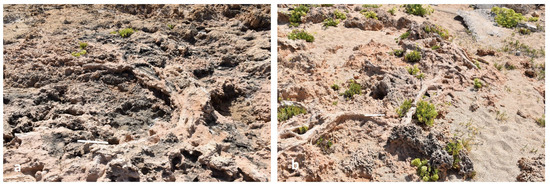
Figure 10.
(a) Extensive laterally branching fossilized root system on hardpan surface. Calcified roots preserve complex bifurcating architecture with micritic carbonate precipitated around roots; (b) Well-preserved network of horizontally sprawling fossilized roots in friable carbonate-rich aeo-lianite. Branching morphology indicates early diagenetic calcification in vegetated dune setting. Scale: 25 cm white ruler. Positions number/coordinates: (a)/11-35.593517512982, 24.094175210526, (b)/10-35.593392169182, 24.094227885108 (in WGS 84).
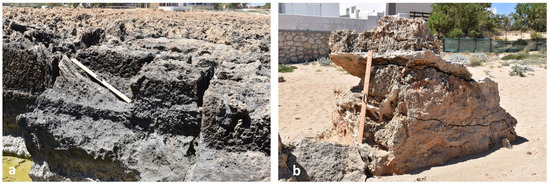
Figure 11.
(a) Thick, unbranched fossilized roots in parallel orientation within aeolianite. No visible branching suggests primary roots of larger plants in compact or quickly buried conditions. Size and spacing indicate deep-rooting vegetation with early carbonate cementation preserving massive fossilized structures; (b) Vertically oriented, branching fossilized root system beneath hardpan horizon. Root displays multiple lateral branches from central axis, indicating complex rhizosphere. Lateral branching and carbonate encrustation show in situ calcification under stable pedogenic conditions. The scale is provided by a large 100 cm ruler. Positions number/coordinates: (a)/27-35.593335182363, 24.096058483576, (b)/14-35.593292382605, 24.092869603524 (in WGS 84).
By orientation, the rhizoliths can be broadly divided into vertical forms growing through aeolianite layers and horizontal forms, extending laterally through the strata. The orientation likely reflects the original growth patterns of the plant roots in response to water availability and physical barriers within the dune system. Ιn contrast to horizontally spreading branching megarhizoliths (Figure 10a,b), the megarhizoliths developed vertically (Figure 11a,b) and frequently penetrated multiple aeolianite strata, suggesting long-lived vegetation with deep root systems capable of exploiting moisture from lower sedimentary units, and they are often accompanied by well-developed calcrete horizons, desiccation cracks, and root trace assemblages indicative of mature soil profiles. These impressive structures extend vertically through the aeolianite layers, as described by Alonso-Zarza et al. [62]. This subcategory does not refer to the small-sized rhizoliths that appear by the hundreds in a vertical position, but to large root fossils with diameters above 10 cm and lengths exceeding 1 m.
5.3. Microstructural Analysis
Microscopic examination of thin sections from rhizolith samples has revealed valuable information about their internal structure and formation processes. Key observations include internal zonation, with many rhizoliths showing concentric layering. A central void (the original root channel) is often surrounded by layers of calcite deposits that formed as the root decomposed or was gradually replaced by mineral precipitation. Some specimens preserve cellular structures from the original plant roots, particularly in their inner zones. Brown micritic cement appears as a significant component of many rhizoliths, closely associated with root structures and likely resulting from the enhanced activity of soil microorganisms that lived symbiotically with plant roots [63,64].
Following Wright’s [60] classification of microstructures in pedogenic carbonates, many of the features observed in the Stavros rhizoliths can be categorized as biogenic (B-Type) featuring concentric zonation patterns, preserved cellular structures, and brown micritic cement associated with former root channels. The presence of alternating micritic laminations, scattered detrital grains, and bioclastic fragments indicates episodic carbonate precipitation under mixed terrestrial–marine conditions, during rhizolith formation.
Mineralogical identification was achieved through optical petrography. Calcite was recognized by its characteristic optical properties under cross-polarized light, including low-order gray interference colors and distinct cleavage planes. The brown micritic cement (indicated by orange triangles in the figures) was identified by its muddy brown appearance in plane-polarized light and fine crystalline texture, representing calcite precipitated in association with decomposing organic root material.
All specimens demonstrate the biogenic (B-Type) nature of these rhizoliths, with preservation of root morphology and clear evidence of calcification occurring during plant life, supporting the interpretation of active biological processes in their formation. Figure 12a displays prominent micritic laminations (red triangles) showing alternating light and dark bands that reflect episodic carbonate deposition around former root channels. Several root periphery zones (blue triangles) are visible, marking the boundaries where root structures interfaced with the surrounding sediment. Brown root channels (orange triangles) can be observed as darker areas representing the original root pathways. The specimen shows evidence of mixed depositional conditions with some bioclastic components present. Figure 12b shows well-developed concentric micritic laminations (red triangles) with distinct banding patterns. Multiple root channels (orange triangles) are preserved as brown micritic cement areas. Root periphery zones (blue triangles) clearly delineate the transition from root structures to surrounding matrix. The alternating light and dark laminae suggest cyclic deposition processes related to groundwater chemistry fluctuations or microbial activity cycles. Figure 12c exhibits micritic laminations (orange triangle) with less distinct banding compared to other specimens. Root periphery areas (blue triangles) are well-preserved, and bioclastic components (green triangles) are notably present, indicating marine influence during formation. The mixed terrestrial–marine depositional environment is clearly evidenced by the presence of fossil shell fragments. Figure 12d shows intensive micritic lamination patterns (red triangle) with multiple episodes of carbonate precipitation. Root periphery zones (blue triangles) are clearly defined, while detrital grains (yellow triangles) appear as angular to sub-rounded clasts with bright interference colors under cross-polarized light. Bioclastic fragments (green triangles) are scattered throughout, and root channel traces (orange triangle) preserve the original root morphology. Figure 12e displays well-preserved micritic laminations with root channel structures (orange triangles) showing brown micritic cement. Root periphery zones (blue triangles) mark clear boundaries between biogenic and abiogenic structures. Detrital grains (yellow triangles) are abundant, indicating significant clastic input during formation, while bioclastic components (green triangles) suggest continued marine influence. Figure 12f shows complex micritic lamination patterns (red triangles) with multiple root periphery zones (blue triangles) indicating various root penetration episodes. Detrital grains (yellow triangles) are well-distributed throughout the matrix, and bioclastic fragments (green triangles) are present. Root channel areas (orange triangle) preserve traces of the original plant root structures with characteristic brown micritic cement.
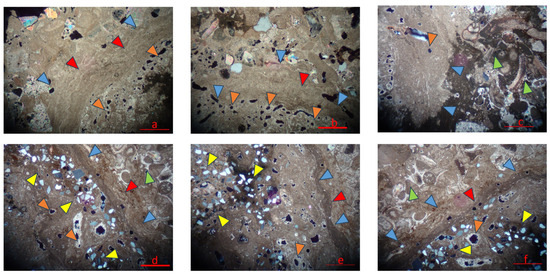
Figure 12.
Figures of rhizolith thin sections from Stavros Bay aeolianites under transmitted light microscopy (a–f), showing biogenic carbonate structures with color-coded annotations: blue triangles indicate root periphery zones, orange triangles mark root channels, red triangles highlight micritic laminations, yellow triangles point to detrital grains, and green triangles identify bioclastic components. Scale bars represent 1 mm.
All specimens in Figure 13a–f demonstrate the biogenic nature of these rhizoliths, with carbonate accumulation associated with former root activity and complex interactions involving root decay, microbial activity, and fluctuating groundwater conditions typical of coastal carbonate paleosol environments. Figure 13a displays multiple well-developed rhizolith structures with clear circular to elliptical morphologies. Root periphery zones (blue triangles) define the boundaries of former root structures, showing distinct zonation patterns. Root channels (orange triangles) are preserved as brown micritic cement areas, indicating the original root pathways. A micritic lamination (red triangle) shows the concentric carbonate deposition around the root structure. The specimen exhibits characteristic B-type biogenic microstructures with excellent preservation of root morphology. Figure 13b shows a prominent circular rhizolith structure with well-defined concentric zoning. The root periphery (blue triangle) clearly delineates the boundary between the root-derived carbonate and surrounding matrix. Root channels (orange triangles) appear as darker areas with brown micritic cement. The structure displays alternating micritic and microsparitic calcite zones, typical of rhizoliths formed under fluctuating soil moisture conditions. Small dark voids within the structure represent secondary porosity from post-precipitation dissolution processes. Figure 13c exhibits multiple rhizolith structures with root periphery zones (blue triangles) showing clear boundaries and internal organization. Root channels (orange triangles) preserve traces of original root pathways with characteristic brown micritic cement. The surrounding carbonate matrix displays micritic to peloidal textures, indicating pedogenic and microbial processes. The preservation quality suggests calcification occurred primarily before plant death and destruction. Figure 13d shows a large, well-preserved rhizolith with prominent root periphery definition (blue triangles). Root channels (orange triangles) exhibit excellent preservation of internal structures, possibly including epidermal and cortical tissues. Concentric zoning reflects episodic changes in groundwater chemistry and carbonate saturation. Some areas show ring-type structures with central cavities, resulting from preferential calcification of cortical cells. Figure 13e displays clustering of rhizoliths with root channels (orange triangles) showing brown micritic cement accumulation. Root periphery zones (blue triangles) mark clear transitions between biogenic and surrounding matrix materials. The structures exhibit geopetal features with some pores partially filled by sediment or secondary carbonate, indicating complex post-depositional processes in the coastal carbonate paleosol environment. Figure 13f shows well-developed rhizolith structures with clear root periphery boundaries (blue triangles) and root channels (orange triangles) preserving original root morphology. The specimen exhibits characteristic concentric laminations and micritic envelopes reflecting seasonal or climatic variations in groundwater conditions. The fine preservation of internal microstructures supports interpretation as root-derived secondary carbonate accumulations formed under semi-arid pedogenic conditions.
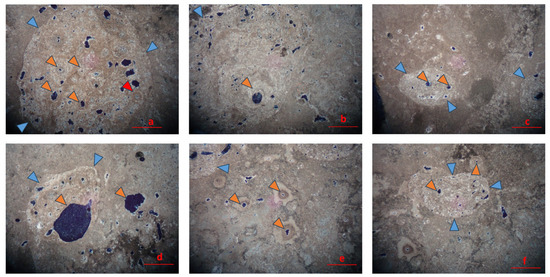
Figure 13.
Figures of rhizolith thin sections from Stavros Bay aeolianites under transmitted polarized light (a–f), showing concentric carbonate zonation around former root channels. Colored triangles indicate the following: blue—root periphery zones; orange—root channels with brown micritic cement; red—micritic laminations. Scale bars = 1 mm.
5.4. Fossilized Trunks, Stumps and Tree Branches
Beyond rhizoliths and associated sedimentary features, the Stavros site also contains actual petrified plant remains. These include small, petrified trunks (in situ, standing specimens representing smaller shrub-like plants), standing petrified trunks (larger tree specimens preserved in their growth position), inclined petrified trunks, and petrified branches showing various branching patterns. The presence of fossilized upright tree trunks at Stavros Bay provides robust evidence of rapid burial events, essential to preserving woody tissues before decomposition could proceed extensively. Standing petrified trunks (Figure 14 and Figure 15) vary in size, some representing shrub-like vegetation only a few centimeters thick and others much larger—up to half a meter or more in diameter—indicating mature trees. These fossilized trunks, preserved in their original growth positions, underscore episodes of rapid aeolian sediment accumulation that entombed the vegetation, facilitating calcification rather than the more commonly observed processes of silicification or calcification. Calcification as a preservation mechanism [25] involves precipitation of calcium carbonate around or within decaying plant tissues, resulting in exceptional three-dimensional preservation of anatomical detail within coastal carbonate environments.
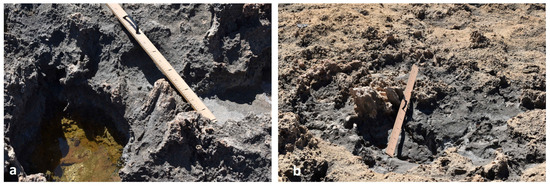
Figure 14.
(a) Irregular depressions in lithified coastal carbonate rocks interpreted as tree pits—erosional remnants of fossilized tree bases. These cavities likely formed around calcified trunks later removed by erosion, leaving biogenic molds. Surrounding substrate consists of cemented aeolianite shaped by subaerial exposure and diagenetic alteration; (b) Calcified tree stump preserved vertically within friable carbonate-rich aeolianite. Structure retains branching morphology with associated rhizolith fragments on surface. Scale: 100 cm ruler. Positions number/coordinates: (a)/26-35.593322897727, 24.096052353328, (b)/22-35.593480069879, 24.093825143224 (in WGS 84).
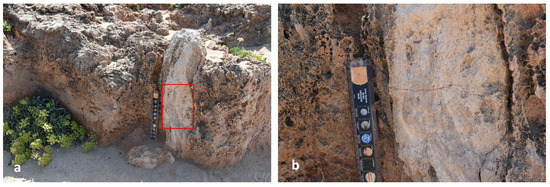
Figure 15.
(a) In situ upright fossilized tree trunks in growth position within carbonate aeolianite. Vertical orientation and clustering indicate rapid burial by aeolian sands before decomposition, supporting interpretation as petrified forest under coastal dune conditions. Calcification preserved both below-ground and above-ground structures. The red-boxed area in Figure 15a is shown at higher magnification in Figure 15b; (b) Close-up of calcified fossil trunk showing preserved cortical texture and concentric features. Scale: 35 cm ruler. Positions number: (a,b)/2-35.592988509275, 24.095543921843 (in WGS 84).
The four photographs of Figure 16 reveal a well-preserved fossilized tree trunk that has undergone complete petrification, displaying exceptional three-dimensional preservation of the original organic material. The specimen lies horizontally in and on aeolianites, measuring approximately 1.5 m in visible length with a cylindrical to slightly tapered form characteristic of natural tree trunk morphology. The external surface exhibits remarkable preservation of bark texture through irregular, rough calcification that maintain the original bark patterns, while differential weathering has created varied erosion patterns where some portions show greater resistance to weathering than others. The fossilized trunk demonstrates the characteristic features of petrified wood, where organic materials have been replaced by stone through mineralization processes. Internal structural features are clearly visible, particularly the preserved growth rings that appear more pronounced due to differential weathering effects. The concentric ring structures radiating from the center are evident in cross-sectional views, along with possible preservation of wood grain patterns and evidence of mineralization that has replicated cell walls with minerals while retaining aspects of the original stem tissue structure. Unlike typical plant fossils, which are usually impressions or compressions, this petrified wood represents a complete three-dimensional preservation of the original organic material. The specimen shows evidence of complete mineralization of organic tissues, retention of original structural patterns, and possible calcification based on the exceptional preservation quality. The surrounding sedimentary rock matrix suggests burial in fine-grained sediments consistent with environments where wood becomes buried underwater deposits, creating the anoxic conditions necessary for petrification to occur rather than decomposition.
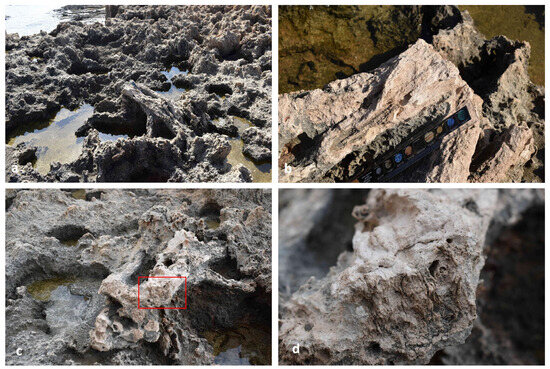
Figure 16.
Fossilized tree trunk shows exceptional petrification preservation in and on coastal aeolianites. (a) Overall view of horizontally lying petrified trunk showing preserved bark texture and cylindrical morphology; (b) Detail of preserved growth ring structures made visible through differential weathering; (c) Trunk section within sedimentary rock matrix with measurement scale (red box indicates detailed area); (d) Cross-sectional view revealing concentric growth rings and internal wood structure preservation through mineralization processes.
In addition to upright trunks, Stavros features an abundance of inclined and horizontally preserved woody branches (Figure 17) that are typically larger and more robust than the associated root structures. These branches maintain relatively uniform diameters, generally ranging between five and ten centimeters, and exhibit distinct branching nodes consistent with aerial woody plant parts rather than subterranean root structures. The preserved surfaces of these fossilized branches are characterized by rugged, porous textures resulting from differential carbonate precipitation, subsequent weathering, and exposure-related recrystallization processes. Such textures highlight prolonged interaction between the buried organic material and carbonate-rich solutions, driven by fluctuations in groundwater levels, periodic exposure to subaerial conditions, and microbial-mediated calcification processes common in coastal dune settings. The calcified branches observed at Stavros exhibit cylindrical geometry and prominent robust features, differentiating them clearly from rhizoliths, which typically display tapering morphology and fine concentric microzonation patterns resulting from gradual carbonate precipitation around roots. The fossil branches, instead, present a clear signature of woody stems preserved through pervasive mineral precipitation.
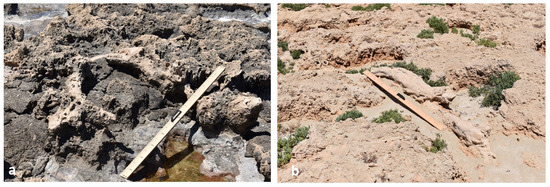
Figure 17.
(a,b) The figures illustrate elongated, robust fossilized structures identified clearly as fossilized tree branches preserved within carbonate-rich aeolian deposits, distinguished morphologically and dimensionally from typical rhizoliths. The scale is provided by a large 100 cm ruler. Positions number/coordinates: (a)/21 35.593458005833, 24.093547531782, (b)/23-35.593104736876, 24.09565179972 (in WGS 84).
The wider area, thus, offers an integrated record of multiple ecological levels—from subterranean root systems forming rhizolithic networks to upright trunks and large aerial branches. Each component provides critical insight into the Quaternary paleoenvironment, including the vegetation structure, soil stabilization processes, diagenetic regimes, and the periodic rapid sedimentation events typical of coastal dune ecosystems. The extensive rhizolith networks and calcified woody structures indicate repeated phases of dune stabilization, vegetation colonization, and subsequent entombment by carbonate sands, marking cycles of pedogenesis [46] and sedimentological dynamics. The exceptional preservation of plants remaining at Stavros Bay through calcification provides a valuable paleoecological dataset. This information significantly enhances the understanding of plant-sediment interactions in coastal carbonate environments, particularly in reconstructing the ecological dynamics and environmental changes experienced during the Quaternary period. The comprehensive nature of these fossilized structures, spanning below-ground and above-ground plant components, distinguishes Stavros Bay as a site of substantial paleoenvironmental and geological importance.
5.5. Dissolution Pipes
Another significant feature of the site at Stavros Bay (Figure 18a,b), is the extensive presence of dissolution pipes (solution pipes), vertical cylindrical karst dissolution structures developed within aeolianite formations. It has been generally accepted that dissolution pipes represent an intricate interaction of geological, hydrological, and biological processes. Their formation is primarily driven by chemical dissolution facilitated by vegetation, although exact mechanisms vary significantly based on local conditions and the interplay of multiple environmental factors. Dissolution pipes are characterized by their cylindrical morphology, sometimes narrowing towards their base, creating cigar-shaped profiles. Typically, these structures form above paleosols and within aeolianite clusters. Their dimensions can vary significantly, with diameters exceeding 4 m and depths surpassing 100 m. The maximum depth for pipes developed in vadose conditions is generally controlled by the depth of the water table or sea level. These cylindrical features are primarily generated by carbonate dissolution, triggered by percolating acidic waters, often facilitated by biological activity, notably plant roots. The presence of abundant rhizoliths within and around these dissolution pipes highlights the significant influence of vegetation on their formation. Roots and plant stems enhance carbonate dissolution by producing organic acids and elevated CO2 levels in the rhizosphere [65], thus, intensifying chemical weathering processes. Dissolution pipes are characterized by their cylindrical morphology, sometimes narrowing towards their base, creating cigar-shaped profiles. Typically, these structures form above paleosols and within aeolianite clusters. Their dimensions can vary significantly, with diameters exceeding 4 m and depths surpassing 100 m. The maximum depth for pipes developed in vadose conditions is generally controlled by the depth of the water table or sea level.
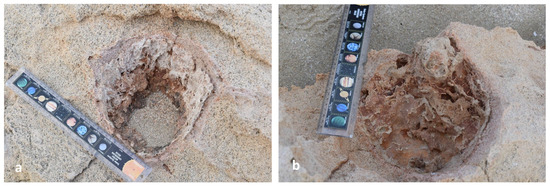
Figure 18.
Vertical solution pipes within aeolianites at Stavros Bay, Akrotiri, partially infilled (a) and contain fossilized rhizoliths; (b) These root traces likely initiated localized carbonate dissolution, forming the pipes under semi-arid conditions with episodic soil formation. Positions number/coordinates: (a)/3-35.593101470433, 24.09541601573, (b)4-35.593088992936, 24.095425671009 (in WGS 84).
At Stavros Bay, these dissolution pipes often feature distinct secondary calcite linings several centimeters thick. These linings, composed predominantly of microsparite and micritic carbonate, form concentric layers that follow the internal shape of the pipes. Due to their reduced porosity and enhanced resistance to weathering, these calcrete linings frequently persist as prominent features following the erosion of adjacent, less resistant host rock. Interestingly, some dissolution pipes within aeolianite at Stavros Bay (Figure 18b) exhibit cross-cutting by small faults featuring developed calcareous crusts. This evidence indicates that dissolution pipes predate faulting events in their host aeolianites, offering valuable chronological constraints on the geomorphological evolution of the site.
The interaction of biological and hydrological processes plays a pivotal role in dissolution pipe formation. Tree roots, evidenced by rhizoliths, significantly contribute through biological activity. However, the extent of their necessity is debated. Some researchers suggest that smaller vegetative patches can also initiate pipe formation under suitable moisture conditions, challenging the notion that large trees are essential. This debate underscores the complexity and variability in pipe genesis mechanisms across different environments [66,67].
Particularly interesting structures identified at Stavros Bay include what appear to be “rock pools” or tree pit structures like those documented at the Longcraig Limestone in Catcraig, Scotland [68]. These cavities (Figure 19a–d), which are surrounded and containing calcified residues of rhizoliths, represent the positions of tree-sized plants that belonged to a petrified forest. Several dozens of these cavity structures have been identified along the eastern coastal front at Stavros Bay. Many of these cavities are filled with remnants of fossilized roots and rhizoliths, further supporting their interpretation as tree pits rather than simple erosional features. This interpretation aligns with similar findings in other Quaternary carbonate-rich environments where vegetation has played a significant role in landscape development.
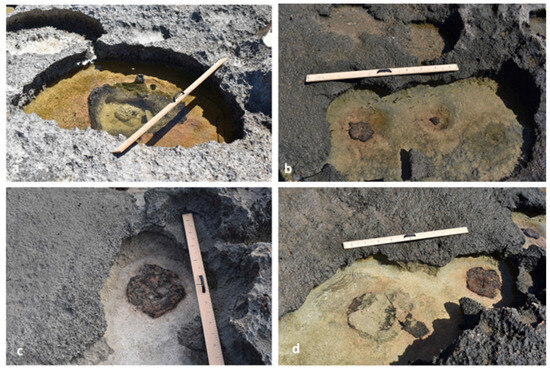
Figure 19.
(a-d) “Rock pools” or tree pit-like depressions in aeolianites at Stavros Bay, Akrotiri, resembling root hollows from the Late Visean fossil forest at Catcraig, Scotland [68]. Likely formed by root growth and decay, these features reflect early pedogenesis and vegetative stabilization of the substrate. The scale is provided by a large 100 cm ruler. Positions number/coordinates: (a)/28-35.593418010517, 24.095942309213, (b)/29-35.593459973927, 24.095782956694, (c)/31-35.593201603688, 24.095580713879, (d)/32-35.59344270331, 24.095549406964 (in WGS 84).
6. Sedimentological and Mineralogical Characteristics of Aeolianites and Beach Sands of Stavros Bay
As mentioned above, the name that has prevailed not only for the beach but for the whole area and which comes from the name of the local community is Stavros Bay and is used in various scientific publications. Within this area, Stavros Bay is a small pocket beach located west of the alpine formation, is only 0.2 km long and hosts a sandy coast (Figure 1). The beach sediments at Stavros Bay consist mainly of medium and coarse sand, with grain size measurements showing moderately well or well-sorted samples that are symmetrical or slightly negatively skewed, and mesokurtic or leptokurtic in distribution. The mineral composition at Stavros Bay reveals an exceptionally high carbonate content (90%), making it one of the beaches with the highest carbonate proportion among the 22 studied beaches in Crete. Low-Mg calcite is the dominant mineral in these sediments. This high carbonate content is consistent with the beach’s location in a nearly pure limestone area, where coastal formations serve as the primary sediment source. The area experiences summer winds called Etesians or Meltemi, which are mainly from the NW direction. These winds are typically light to moderate and remarkably steady in direction. Winter winds are more variable but generally from NW with a secondary W mode. The predominant waves reach Stavros Bay from the NNE direction, affecting sediment transport patterns. Interestingly, Stavros Bay exhibits an unusual pattern where non-carbonate grains show better roundness than carbonate grains, contrary to the pattern observed at most other beaches of Crete the results of which are presented in the same study. There is also a river discharging onto the beach, which contributes to the sediment composition and transport dynamics. The beach features dunes in its backshore area, with a width ranging from 8 to 20 m and a moderate beach face slope of 4–13° [69] These two dominant wind directions are also reflected in the surfaces of the fossilized dunes that were measured and documented in Figure 20.
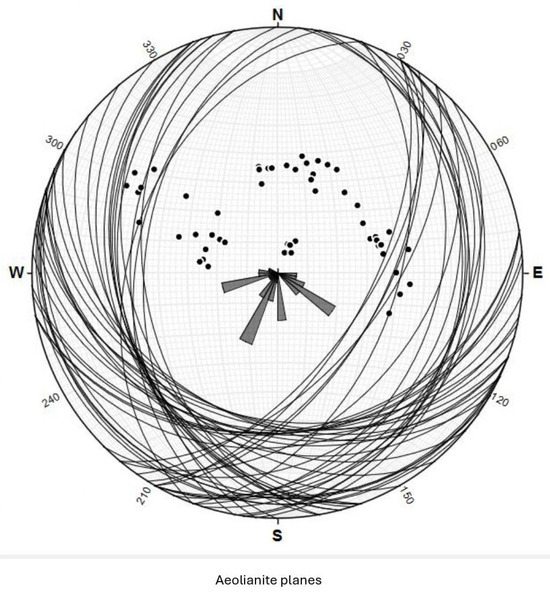
Figure 20.
The visualization effectively illustrates the spatial orientation of cross-bedded layer surfaces within the aeolianites of Stavros quarry. The figure shows a lower hemisphere stereonet where dots represent poles to aeolianite planes, lines represent the planes derived from these poles, and arrows indicate the rose diagram showing the dominant orientation trends. Two dominant directions are discernible: south-southeast (SSE) and south-southwest (SSW), accompanied by subtle directional variations of a few degrees.
The stereographic projection analysis reveals a clear bimodal distribution of cross-bedding orientations, with the primary cluster oriented toward the southeast, indicating formation under the influence of the dominant NW Etesian winds. A secondary, less pronounced cluster shows orientations consistent with the variable winter wind patterns from the ΝΕ direction. This paleoenvironmental evidence demonstrates the consistency of regional wind patterns, with the aeolianite cross-bedding preserving a record of the same atmospheric circulation patterns that continue to influence the area today. The concentration of measurements around these two primary orientations suggests that dune formation occurred during periods when these wind regimes were particularly stable and persistent.
In addition to the analysis on sands from Stavros Bay, grain size and chemical analyses have been carried out on a total of 14 samples of aeolianites from Stavros Bay [53]. According to the results of this study, the proximity to the coast facilitates the transfer of new material from beach sand, particularly foraminifera shells. Both beach sand and aeolian deposits consist predominantly of these shells. Aragonite similarly shows a decreasing trend from coast to interior, with sample 5 being an exception. This anomaly may result from enrichment with light fragments of organic materials, as sample 5 originates from the most remote aeolian deposits and has the finest grain size. The total carbonate content (including clastic, organic, and cement components) reaches 97%. Quartz pre-dominates in insoluble material, with illite and kaolinite also present. Magnesium calcite appears in noticeable quantities, and these aeolianites exhibit excellent diagenesis.
To determine the mineralogy of the aeolianites at the Stavros–Trachili quarry, sampling was carried out according to the principle of maximum representation, with medium-sized samples of centimeter-scale dimensions collected from scattered fragments throughout the site [70]. In situ sampling from bedrock was strictly prohibited due to the archaeological significance of the location. A total of ten samples (S1–S10) were collected for analysis, varying in size and shape. From each original sample, three cores were extracted using a drill press. Following core extraction from the initial samples, the mineralogical composition of the aeolianite samples was determined using X-ray diffraction (XRD) analysis with a Bruker-AXS D8 Advance diffractometer (Bruker AXS GmbH, Karlsruhe, Germany) and DIFFRAC.EVA software.The XRD analysis revealed that the aeolianite samples are predominantly composed of calcium carbonate minerals, with calcite and magnesian calcite being the major phases (Table 1). Sample 1–1 contained 86.6% calcite and 7.4% magnesian calcite, while sample 2–1 showed 89.5% magnesian calcite with no detectable calcite. Samples 2–3, 3–2, and 10–2 were dominated by pure calcite at concentrations of 94.8%, 95.4%, and 96.0%, respectively. In contrast, samples 3–3, 4–1, 5–2, 7–3, 8–2, 8–3, 9–2, and 10–1 contained primarily magnesian calcite ranging from 63.7% to 89.2%. Quartz content varied across all samples from 1.0% to 6.1%, with the highest concentration found in sample 5–2. Aragonite concentrations ranged from 2.4% to 19.3%, with sample 7–3 showing the highest content. Dolomite was present in all samples at levels between 0.4% and 17.5%, with sample 5–2 again showing the highest concentration. Halite was detected only in samples 2–1 and 3–3 at concentrations of 1.4% and 6.2%, respectively.

Table 1.
Quantitative mineralogical composition (wt%) of aeolianite samples from Stavros–Trachili quarry based on XRD analysis.
This mineralogical composition is typical of coastal aeolianites formed from carbonate-rich marine sediments. The presence of aragonite suggests preservation of original marine carbonate phases in some samples, while the occurrence of dolomite indicates post-depositional diagenetic processes. The detection of halite in certain samples suggests the influence of salt spray from the marine environment. The varying quartz content reflects different degrees of siliciclastic input during the formation of these aeolianite deposits, providing valuable insights into the paleoenvironmental conditions.
7. Discussion
The Rhizolith Petrified Forest of Chania at Stavros Bay represents a distinct preservation type compared to many documented fossil forests. The Stavros site features fossilized root systems preserved through calcium carbonate mineralization within Pleistocene aeolianites [5,10]. This preservation mechanism differs from both silicified and carbonated fossil woods found at other sites, particularly because it preserves the root structures rather than just tree trunks. The site provides valuable insight into Pleistocene coastal environments that complement the broader spectrum of fossil forest preservation types documented globally. This calcification process involved the precipitation of calcium carbonate resulting in even the rare but extraordinary three-dimensional preservation of external anatomical details. The site features Greece’s first documented location with extensive rhizoliths, ranging from small diameter specimens to mega-rhizoliths exceeding 1 m in length, with distinctive morphological and structural characteristics. Various branching patterns are observed, with some complex networks covering several square meters. Ιn comparison with other areas where rhizoliths have been studied, four principal rhizolith types are identified based on morphology and dimensions: small-sized specimens (few centimeters), medium-sized formations (several centimeters), mega-rhizoliths exceeding one meter, and branched mega-rhizoliths with extensive branching patterns sometimes covering many square meters. According to microscopic examination and established classifications [60,71], many features observed in the Stavros Bay calcified root structures can be categorized as biogenic (B-Type), supporting the interpretation that calcification preceded substantial plant decay. The site contains various preserved plant remains beyond the rhizoliths, including small-diameter woody stems (shown in Figure 13a,b), upright petrified trunks preserved in growth position, tilted petrified trunks at various angles to horizontal, and petrified branches exhibiting different branching patterns. This comprehensive preservation of both below-ground and above-ground plant components provides compelling evidence of a genuine fossilized forest rather than isolated specimens. The presence of fossilized upright tree trunks indicates rapid burial events essential for preserving woody tissues before extensive decomposition. Associated geological phenomena include dissolution pipes (solution pipes)—vertical cylindrical karst dissolution structures developed within aeolianite formations. These structures result from carbonate dissolution triggered by percolating acidic waters, often facilitated by biological activity and plant roots. The abundant rhizoliths within and surrounding these dissolution pipes emphasize vegetation’s substantial influence on their formation. Additional biokarstic features including “rock pools” further illustrate the complex geological history and provide valuable evidence for understanding biokarstic formation mechanisms as discussed in the international literature [65,67,72].
As paleoenvironmental indicators, the Stavros Bay rhizoliths provide crucial insights into past ecological conditions. The calcification preservation mechanism indicates episodic soil drying periods [28], while alternating aeolianite, calcrete horizons and paleosol layers suggest cyclical environmental changes—periods of active dune formation alternating with more stable conditions allowing soil development and vegetation establishment. The rhizosphere characteristics clearly indicate terrestrial conditions and/or subaerial exposure in what were likely marine sediments. Although some researchers suggest most rhizoliths inadequately preserve plant morphological structures [39,73], the excellent preservation quality, diverse sizes, varied morphological characteristics, and remarkable abundance of rhizoliths at Stavros Bay offer promising potential to provide information not only about the alternating paleoenvironmental conditions of the area, but also about the plant species whose roots and various other anatomical parts became fossilized. The Stavros Bay rhizoliths may contribute to Mediterranean paleoenvironmental understanding. The presence of T0 tree trunks, which can provide information about tree size and density in the fossilized plant community, adds to the site’s scientific value. Even small remnants have become research subjects globally, exemplified by the Longcraig Limestone at Catcraig, Scotland [68]. The paleosols associated with the Stavros Bay rhizoliths constitute important information sources regarding this dynamically changing region.
The Stavros Bay geotope encompasses both geological importance and rich historical context. This former Venetian extraction site bears the marks of intensive quarrying activities spanning from Minoan to medieval times. The location gained additional recognition through its appearance in the iconic film “Zorba the Greek” [74], enhancing its cultural heritage value. This integration of geological, historical, and cultural elements parallel other significant rhizolith sites including Egypt’s Wadi El-Hitan UNESCO site [59], Tanzania’s Olduvai Gorge [75], Kenya’s Lake Turkana Basin [76], and Australia’s Pinnacle Karst at Nambung National Park [66]. While the Venetian quarry receives protection under archaeological legislation, the extraordinary geological value necessitates recognition and protection as a distinct natural monument capable of attracting scientific investigation, educational interest, and sustainable geotourism development. Certain locations require immediate implementation of environmentally appropriate restrictive access measures to protect these unique but friction-sensitive fossilized structures. Each year, thousands of tourists visit the quarry site and walk across fossilized roots without recognizing them and consequently without taking proper care. There are already areas where the rhizoliths have suffered damage from friction. In conclusion, the Rhizolith Petrified Forest of Chania constitutes a site of exceptional paleoenvironmental and geological significance, providing invaluable insights into ancient ecological conditions, hydrological regimes, and pedogenic processes during the Quaternary period.
8. Conclusions
The Rhizolith Petrified Forest of Chania at Stavros Bay represents a valuable component of Crete’s and Greece’s natural and cultural heritage, emphasizing the connection between geological history and human activities, and preserving the memory of the landscape. This discovery not only will gradually enrich our knowledge of Crete’s paleobotanical history but also adds a unique site to Greece’s inventory of geological and paleontological heritage deserving preservation and scientific study. The conservation and scientific study of this site align with global geoheritage preservation efforts [77,78]. The site has potential not only for scientific research but also for educational programs and sustainable geotourism development that could benefit the local community while ensuring the site’s preservation for future generations.
The rhizoliths of the Stavros Bay and others petrified plant remains represent a significant paleobotanical discovery that warrants comprehensive documentation and protection. The abundance, diversity, and excellent preservation of these fossilized root systems make this site of special value of Greece and rare worldwide. Future research should focus on detailed mapping of the site, comprehensive documentation of rhizolith morphologies, potential identification of parent plant species, precise dating, more extensive study of the paleosols, and integration with regional paleoenvironmental records to enhance our understanding of Mediterranean paleoecology during the time the petrified forest was formed.
Supplementary Materials
The following supporting information can be downloaded at: https://www.mdpi.com/article/10.3390/heritage8070242/s1, Figure S1: Geological map of Chania with watermark; Table S2: Field positions of paleontological and sedimentological features _Coordinates EGSA 87; Table S3: Field positions of paleontological and sedimentological features _Coordinates WGS 84; Image S4: KLM file; Table S5: Aeolianite planes measurements.
Funding
The Tourism Department of the Regional Unit of Chania, of the Region of Crete, funded the relevant research for one year (2023). The management of the program «Research-study for the promotion of Petrified Forest of Chania” with code 82861 was carried out by the Special Account for Research Funding of the Technical University of Crete.
Data Availability Statement
Specimens used in this study are archived in E.M.’s research collection at the School of Mineral Resources Engineering, Technical University of Crete; they are available for study by other researchers.
Acknowledgments
George Kritikakis made a decisive contribution to the real-time kinematic positioning (RTK) of rhizoliths and other structures. The photography of thin sections was carried out with the assistance of George Triantafyllou. Both are Laboratory Teaching Staff at the School of Mineral Resources Engineering, Technical University of Crete.
Conflicts of Interest
The author declares no conflicts of interest.
References
- Moody, J.; Rackham, O.; Rapp, G. Environmental Archaeology of Prehistoric NW Crete. J. Field Archaeol. 1996, 23, 273–297. [Google Scholar] [CrossRef]
- Melfi, M. Cretan Nymphs: An Attic Hypothesis. In Essays in Classical Archaeology for Eleni Hatzivassiliou 1977–2007; Kurtz, D., Meyer, C., Saunders, D., Tsingarida, A., Harris, N., Eds.; The Beazley Archive and Archaeopress: Oxfordshire, UK, 2008; Volume IV, pp. 221–227. [Google Scholar]
- Tziligkaki, E. The Ancient Quarries of Crete. Ph.D. Thesis, University of Crete, Rethymno, Greece, 2014. [Google Scholar]
- Tziligkaki, E. Quarrying the Coasts of Crete in Antiquity; Some Geoarchaeological Considerations. Bull. Geol. Soc. Greece 2018, 53, 229–265. [Google Scholar] [CrossRef]
- Manoutsoglou, E. Rhizoliths within Aeolianites at the Ancient Quarry of Stavros Akrotiri Chania Greece. In Proceedings of the 16th International Congress of the Geological Society of Greece, Patras, Greece, 17–19 October 2022; p. 193, Bulletin of the Geological Society of Greece, 2022. [Google Scholar]
- Masi, U.; Azzaro, E.; Kyriakopoulos, K.; Magganas, A. Geochemical Features of the «plattenkalk» Series from the Hordaki Area (Western Crete, Greece). Period. Mineral. 2000, 69, 311–323. [Google Scholar]
- Economou, N.; Kritikakis, G.; Manoutsoglou, E.; Vafidis, A. Fast and Efficient Void Detection in Carbonates by Combined ERT and Borehole Data: A Case Study from Chania Airport in Greece. Lead. Edge 2022, 41, 322–330. [Google Scholar] [CrossRef]
- Karageorgiou, E.D.; Tsaila-Monopoli, S. Geological Map of Greece, Sheet Khania, Scale 1:50,000; Institute for Geology and Subsurface Research: Athens, Greece, 1971. [Google Scholar]
- Freudenthal, T. Stratigraphy of Neogene Deposits in the Khania Province, Crete, with Special Reference to Foraminifera of the Family Planorbulinidae and the Genus Heterostegina. Utrecht Micropaleontol. Bull. 1969, 1, 1–208. [Google Scholar]
- Zamani, A.; Maroukian, H. A Morphotectonic Investigation in Northwestern Crete: The Peninsula of Akrotiri. Z. Geomorphol. 1981, Suppl. 40, 151–164. [Google Scholar]
- Stiros, S.C. The 8.5+ Magnitude, AD365 Earthquake in Crete: Coastal Uplift, Topography Changes, Archaeological and Historical Signature. Quat. Int. 2010, 216, 54–63. [Google Scholar] [CrossRef]
- Mourtzas, N.; Kolaiti, E.; Anzidei, M. Vertical Land Movements and Sea Level Changes along the Coast of Crete (Greece) since Late Holocene. Quat. Int. 2016, 401, 43–70. [Google Scholar] [CrossRef]
- Kokkorou-Alevra, G.; Poupaki, E.A.E.; Chatzikonstantinou, A. Corpus of Ancient Quarries; Section of Archaeology and History of Art, National and Kapodistrian University of Athens: Athens, Greece, 2014. [Google Scholar]
- Kelletat, D. Geomorphologische Studien an Den Küsten Kretas. Beiträge zur regionalen Küstenmorphologie des Mittel-meerraumes. Abh. Akad. Wiss. Göttingen Math.-Phys. Kl. Dritte Folge 1979, 32, 1–105. [Google Scholar]
- Gutiérrez Garcia-Moreno, A. Roman Quarries in the Northeast of Hispania (Modern Catalonia). Ph.D. Thesis, Universitat Autònoma de Barcelona, Bellaterra, Spain, 2009. [Google Scholar]
- Moody, J.A. The Environmental and Cultural Prehistory of the Khania Region of West Crete: Neolithic through Late Minoan III. Ph.D. Thesis, University of Minnesota, Minneapolis, MN, USA, 1987. [Google Scholar]
- Klappa, C.F. Rhizoliths in Terrestrial Carbonates: Classification, Recognition, Genesis and Significance. Sedimentology 1980, 27, 613–629. [Google Scholar] [CrossRef]
- Khechai, S.; Daoud, Y. Characterization and Origin of Gypsum Rhizoliths of Ziban Oases Soil-Algeria. World Appl. Sci. J. 2016, 34, 948–955. [Google Scholar]
- Jones, B.; Renaut, R.W.; Rosen, M.R.; Klyen, L. Primary Siliceous Rhizoliths from Loop Road Hot Springs, North Island, New Zealand. J. Sediment. Res. 1998, 68, 115–123. [Google Scholar] [CrossRef]
- Gocke, M.; Kuzyakov, Y.; Wiesenberg, G.L.B. Rhizoliths in Loess—Evidence for Post-Sedimentary Incorporation of Root-Derived Organic Matter in Terrestrial Sediments as Assessed from Molecular Proxies. Org. Geochem. 2010, 41, 1198–1206. [Google Scholar] [CrossRef]
- Gocke, M.; Gulyás, S.; Hambach, U.; Jovanović, M.; Kovács, G.; Marković, S.B.; Wiesenberg, G.L.B. Biopores and Root Features as New Tools for Improving Paleoecological Understanding of Terrestrial Sediment-Paleosol Sequences. Palaeogeogr. Palaeoclimatol. Palaeoecol. 2014, 394, 42–58. [Google Scholar] [CrossRef]
- Sun, Q.; Zamanian, K.; Huguet, A.; Bayat, O.; Wang, H.; Badawy, H.S. Genesis and Soil Environmental Implications of Intact In-Situ Rhizoliths in Dunes of the Badain Jaran Desert, Northwestern China. Acta Geochim. 2022, 41, 811–822. [Google Scholar] [CrossRef]
- Sun, Q.; Zamanian, K.; Huguet, A.; Fa, K.; Wang, H. Characterization and Formation of the Pristine Rhizoliths around Artemisia Roots in Dune Soils of Tengeri Desert, NW China. Catena 2020, 193, 104633. [Google Scholar] [CrossRef]
- McNear, D.H. The Rhizosphere—Roots, Soil and Everything In Between. Meeting the Global Challenge of Sustainable Food, Fuel and Fiber Production. Nat. Educ. Knowl. 2013, 4, 1. [Google Scholar]
- Alonso-Zarza, A.M. Study of a Modern Calcrete Forming in Guadalajara, Central Spain: An Analogue for Ancient Root Calcretes. Sediment. Geol. 2018, 373, 180–190. [Google Scholar] [CrossRef]
- Gocke, M.; Pustovoytov, K.; Kühn, P.; Wiesenberg, G.L.B.; Löscher, M.; Kuzyakov, Y. Carbonate Rhizoliths in Loess and Their Implications for Paleoenvironmental Reconstruction Revealed by Isotopic Composition: Δ13C, 14C. Chem. Geol. 2011, 283, 251–260. [Google Scholar] [CrossRef]
- Esperante, R.; Rodríguez-Tovar, F.J.; Nalin, R. Rhizoliths in Lower Pliocene Alluvial Fan Deposits of the Sorbas Basin (Almería, SE Spain). Palaeogeogr. Palaeoclimatol. Palaeoecol. 2021, 567, 110281. [Google Scholar] [CrossRef]
- Kraus, M.J.; Hasiotis, S.T. Significance of Different Modes of Rhizolith Preservation to Interpreting Paleoenvironmental and Paleohydrologic Settings: Examples from Paleogene Paleosols, Bighorn Basin, Wyoming, U.S.A. J. Sediment. Res. 2006, 76, 633–646. [Google Scholar] [CrossRef]
- Luciano do Nascimento, D.; Batezelli, A.; Bernardes Ladeira, F.S. First Record of Lobed Trace Fossils in Brazil’s Upper Cretaceous Paleosols: Rhizoliths or Evidence of Insects and Their Social Behavior? J. S. Am. Earth Sci. 2017, 79, 364–376. [Google Scholar] [CrossRef]
- do Nascimento, D.L.; Batezelli, A.; Ladeira, F.S.B. The Paleoecological and Paleoenvironmental Importance of Root Traces: Plant Distribution and Topographic Significance of Root Patterns in Upper Cretaceous Paleosols. Catena 2019, 172, 789–806. [Google Scholar] [CrossRef]
- Shumilov, I.K.; Tel’nova, O.P. In Situ Root Systems in the Devonian Paleosols of the Middle Timan. Eurasian Soil. Sci. 2024, 57, 1–8. [Google Scholar] [CrossRef]
- McLaren, S.J. Early Carbonate Diagenetic Fabrics in the Rhizosphere of Late Pleistocene Aeolian Sediments. J. Geol. Soc. 1995, 152, 173–181. [Google Scholar] [CrossRef]
- Alonso-Zarza, A.M.; Sanz, M.E.; Calvo, J.P.; Estévez, P. Calcified Root Cells in Miocene Pedogenic Carbonates of the Madrid Basin: Evidence for the Origin of Microcodium b. Sediment. Geol. 1998, 116, 81–97. [Google Scholar] [CrossRef]
- Golubtsov, V.A.; Khokhlova, O.S.; Cherkashina, A.A. Carbonate Rhizoliths in Dune Sands of the Belaya River Valley (Upper Angara Region). Eurasian Soil. Sci. 2019, 52, 83–93. [Google Scholar] [CrossRef]
- Huguet, A.; Bernard, S.; El Khatib, R.; Gocke, M.I.; Wiesenberg, G.L.B.; Derenne, S. Multiple Stages of Plant Root Calcification Deciphered by Chemical and Micromorphological Analyses. Geobiology 2021, 19, 75–86. [Google Scholar] [CrossRef]
- Bagheri, M.; Feiznia, S.; Arian, M.; Shabanian, R.; Mahari, R. Continental Trace Fossils in the Semnan Area (Northern Iran). Open J. Geol. 2013, 3, 54–61. [Google Scholar] [CrossRef][Green Version]
- Pokorný, R. Rhizobial Root Nodules in Aeolian Sandstones on Madeira (Piedade Beds, Pleistocene) and Their Significance for Palaeonvironmental and “Originator” Hypotheses. Rev. Palaeobot. Palynol. 2022, 306, 104740. [Google Scholar] [CrossRef]
- Owen, R.A.; Owen, R.B.; Renaut, R.W.; Scott, J.J.; Jones, B.; Ashley, G.M. Mineralogy and Origin of Rhizoliths on the Margins of Saline, Alkaline Lake Bogoria, Kenya Rift Valley. Sediment. Geol. 2008, 203, 143–163. [Google Scholar] [CrossRef]
- Jones, B.; Booker, S. Diagenetic Development of Rhizoliths in the Ironshore Formation (Pleistocene) of the Cayman Islands. Sediment. Geol. 2024, 465, 106635. [Google Scholar] [CrossRef]
- Stereonet. Available online: https://www.rickallmendinger.net/stereonet (accessed on 24 May 2025).
- Squatriti, P.; Rackham, O.; Moody, J. The Making of the Cretan Landscape; Manchester University Press: Manchester, UK, 1998; Volume 102. [Google Scholar]
- Paepe, R.; Mariolakos, I.; Van Overloop, E.; Nassopoulou, S.; Hus, J.; Hatziotou, M.; Markopoulos, T.; Manutsoglu, E.; Livaditis, G.; Sabot, V. Quaternary soil-geological stratigraphy in Greece. Bull. Geol. Soc. Greece 2018, 36, 856. [Google Scholar] [CrossRef][Green Version]
- Moraetis, D.; Lydakis-Simantiris, N.; Pentari, D.; Manoutsoglou, E.; Apostolaki, C.; Perdikatsis, V. Chemical and Physical Characteristics in Uncultivated Soils with Different Lithology in Semiarid Mediterranean Clima. Appl. Environ. Soil. Sci. 2016, 2016, 1–13. [Google Scholar] [CrossRef]
- Yaalon, D.H. Soils in the Mediterranean Region: What Makes Them Different? Catena 1997, 28, 157–169. [Google Scholar] [CrossRef]
- Kirsten, F.; Heinrich, J. Soil-Sediment-Configurations on Slopes of Central and Western Crete (Greece) and Their Implications for Late Holocene Morphodynamics and Pedogenesis—A Conceptual Approach. Catena 2022, 214, 106238. [Google Scholar] [CrossRef]
- Retallack, G.J. Field Recognition of Paleosols. Geol. Soc. Am. 1988, 216, 1–20. [Google Scholar] [CrossRef]
- Vousdoukas, M.I.; Velegrakis, A.F.; Plomaritis, T.A. Beachrock Occurrence, Characteristics, Formation Mechanisms and Impacts. Earth Sci. Rev. 2007, 85, 23–46. [Google Scholar] [CrossRef]
- Mauz, B.; Vacchi, M.; Green, A.; Hoffmann, G.; Cooper, A. Beachrock: A Tool for Reconstructing Relative Sea Level in the Far-Field. Mar. Geol. 2015, 362, 1–16. [Google Scholar] [CrossRef]
- Birkeland, P.W. Soil and Geomorphology; Oxford University Press: New York, NY, USA, 1999. [Google Scholar]
- Wright, P.; Tucker, M. Calcretes: An Introduction. In Calcretes; John Wiley & Sons: Hoboken, NJ, USA, 1991; pp. 1–22. [Google Scholar]
- Candy, I.; Black, S. The Timing of Quaternary Calcrete Development in Semi-Arid Southeast Spain: Investigating the Role of Climate on Calcrete Genesis. Sediment. Geol. 2009, 220, 6–15. [Google Scholar] [CrossRef]
- Brooke, B. The Distribution of Carbonate Eolianite. Earth Sci. Rev. 2001, 55, 135–164. [Google Scholar] [CrossRef]
- Fytrolakis, Ν. Geological Investigation of Certain Occurrences of Aeolian Sediments in Crete. Bull. Geol. Soc. Greece 1986, 18, 243–267. [Google Scholar]
- Goudie, A. Calcrete. In Chemical Sediments and Geomorphology; Goudie, A.S., Pye, K., Eds.; Academic Press: London, UK, 1983; pp. 93–131. [Google Scholar]
- Zhou, J.; Chafetz, H.S. Biogenic Caliches in Texas: The Role of Organisms and Effect of Climate. Sediment. Geol. 2009, 222, 207–225. [Google Scholar] [CrossRef]
- Alonso-Zarza, A.M.; Wright, V.P. Chapter 5 Calcretes. In Developments in Sedimentology; Elsevier: Amsterdam, The Netherlands, 2010; pp. 225–267. [Google Scholar]
- Zamanian, K.; Pustovoytov, K.; Kuzyakov, Y. Pedogenic Carbonates: Forms and Formation Processes. Earth Sci. Rev. 2016, 157, 1–17. [Google Scholar] [CrossRef]
- Gee, C.T.; Sander, P.M.; Peters, S.E.; El-Hennawy, M.T.; Antar, M.S.M.; Zalmout, I.S.; Gingerich, P.D. Fossil Burrow Assemblage, Not Mangrove Roots: Reinterpretation of the Main Whale-Bearing Layer in the Late Eocene of Wadi Al-Hitan, Egypt. Paleobiodivers. Paleoenviron. 2019, 99, 143–158. [Google Scholar] [CrossRef]
- Abdel-Fattah, Z.A.; Gingras, M.K. Origin of Compound Biogenic Sedimentary Structures in Eocene Strata of Wadi El-Hitan Universal Heritage Area, Fayum, Egypt: Mangrove Roots or Not? Palaeogeogr. Palaeoclimatol. Palaeoecol. 2020, 560, 110048. [Google Scholar] [CrossRef]
- Wright, V.P. A Micromorphological Classification of Fossil and Recent Calcic and Petrocalcic Microstructures. In Developments in Soil Science; Elsevier: Amsterdam, The Netherlands, 1990; pp. 401–407. [Google Scholar] [CrossRef]
- Sun, Q.; Huguet, A.; Zamanian, K. Outcrop Distribution and Formation of Carbonate Rhizoliths in Badain Jaran Desert, NW China. Catena 2021, 197, 104975. [Google Scholar] [CrossRef]
- Alonso-Zarza, A.M.; Genise, J.F.; Cabrera, M.C.; Mangas, J.; Martín-Pérez, A.; Valdeolmillos, A.; Dorado-Valiño, M. Megarhizoliths in Pleistocene Aeolian Deposits from Gran Canaria (Spain): Ichnological and Palaeoenvironmental Significance. Palaeogeogr. Palaeoclimatol. Palaeoecol. 2008, 265, 39–51. [Google Scholar] [CrossRef]
- Alonso-Zarza, A.M.; Jones, B. Root Calcrete Formation on Quaternary Karstic Surfaces of Grand Cayman. Geol. Acta 2007, 5, 77. [Google Scholar]
- Jones, B.; Ng, K.C. The Structure and Diagenesis of Rhizoliths from Cayman Brac, British West Indies. J. Sediment. Res. 1988, 58, 457–467. [Google Scholar] [CrossRef]
- Lipar, M.; Webb, J.A.; White, S.Q.; Grimes, K.G. The Genesis of Solution Pipes: Evidence from the Middle-Late Pleistocene Bridgewater Formation Calcarenite, Southeastern Australia. Geomorphology 2015, 246, 90–103. [Google Scholar] [CrossRef]
- Lipar, M.; Webb, J.A. The Formation of the Pinnacle Karst in Pleistocene Aeolian Calcarenites (Tamala Limestone) in Southwestern Australia. Earth Sci. Rev. 2015, 140, 182–202. [Google Scholar] [CrossRef]
- Grimes, K.G. Syngenetic Karst in Australia: A Review. Helictite 2006, 39, 27–38. [Google Scholar]
- Alekseeva, T.V.; Mitenko, G.V.; Alekseev, A.O. The Ecology of a Late Visean Forest at Catcraig (East Lothian, Scotland) Based on Multiproxy Study of Paleosol and Root-Casts. Palaeoworld 2021, 30, 62–71. [Google Scholar] [CrossRef]
- Pyökäri, M. Beach Sediments of Crete: Texture, Composition, Roundness, Source and Transport. J. Coast. Res. 1999, 15, 537–553. [Google Scholar]
- Loufardaki, T. Study of Physical and Chemical Properties of Building Stones from the Eastern Side of the Historical Quarry Site at Stavros Akrotiri, Chania; Technical University of Crete: Chania, Greece, 2022; pp. 1–132. [Google Scholar] [CrossRef]
- Kosir, A. Microcodium revisited: Root calcification products of terrestrial plants on carbonate-rich substrates. J. Sediment. Res. 2004, 74, 845–857. [Google Scholar] [CrossRef]
- Lipar, M. Pinnacle Syngenetic Karst in Nambung National Park, Western Australia. Acta Carsologica 2009, 38, 41–50. [Google Scholar] [CrossRef]
- Košir, A. Calcium Carbonate Biomineralisation in Plant Roots and the Rhizosphere: Processes, Products and the Fossil Record. Ph.D. Thesis, Cardiff University, Cardiff, UK, 2022. [Google Scholar]
- Garantoudis, E. Zorba the Greek by Michael Cacoyannis and The Life and State of Alexis Zorba by Nikos Kazantzakis: A comparison in the shadow of the reception of the Kazantzakian work. Comparison 2017, 19, 50–84. (In Greek) [Google Scholar] [CrossRef][Green Version]
- Habermann, J.M.; Stanistreet, I.G.; Stollhofen, H.; Albert, R.M.; Bamford, M.K.; Pante, M.C.; Njau, J.K.; Masao, F.T. In Situ ~2.0 Ma Trees Discovered as Fossil Rooted Stumps, Lowermost Bed I, Olduvai Gorge, Tanzania. J. Hum. Evol. 2016, 90, 74–87. [Google Scholar] [CrossRef]
- Cohen, A.S. Paleoenvironments of Root Casts from the Koobi Fora Formation, Kenya. J. Sediment. Petrol. 1982, 52, 401–414. [Google Scholar] [CrossRef]
- Zouros, N.C. Geomorphosite Assessment and Management in Protected Areas of Greece Case Study of the Lesvos Island—Coastal Geomorphosites. Geogr. Helv. 2007, 62, 169–180. [Google Scholar] [CrossRef]
- Papadopoulou, E.E.; Papakonstantinou, A.; Vasilakos, C.; Zouros, N.; Tataris, G.; Proestakis, S.; Soulakellis, N. Scale Issues for Geoheritage 3D Mapping: The Case of Lesvos Geopark, Greece. Int. J. Geoheritage Parks 2022, 10, 435–446. [Google Scholar] [CrossRef]
Disclaimer/Publisher’s Note: The statements, opinions and data contained in all publications are solely those of the individual author(s) and contributor(s) and not of MDPI and/or the editor(s). MDPI and/or the editor(s) disclaim responsibility for any injury to people or property resulting from any ideas, methods, instructions or products referred to in the content. |
© 2025 by the author. Licensee MDPI, Basel, Switzerland. This article is an open access article distributed under the terms and conditions of the Creative Commons Attribution (CC BY) license (https://creativecommons.org/licenses/by/4.0/).